나노물질








염료감응형 태양전지(DSSC)는 저렴한 비용, 간단한 제조 방법, 낮은 독성 및 생산 용이성으로 인해 20년 이상 광범위한 연구를 수행해 온 박막 태양전지 그룹에 속합니다. 그러나 현재의 DSSC 재료는 높은 비용, 적은 양, 장기 안정성으로 인해 대체할 여지가 많습니다. 기존 DSSC의 효율은 1세대 및 2세대 태양전지, 즉 다른 박막형 태양전지 및 ~ 20–30% 효율을 제공하는 Si 기반 태양 전지. 이 기사는 DSSC 구성, 작동 원리, 주요 문제(낮은 효율성, 낮은 확장성, 낮은 안정성), 잠재적인 효율적인 재료 및 마지막으로 상용화에 대한 간략한 통찰력에 대한 심층 검토를 제공합니다.
<그림><그림>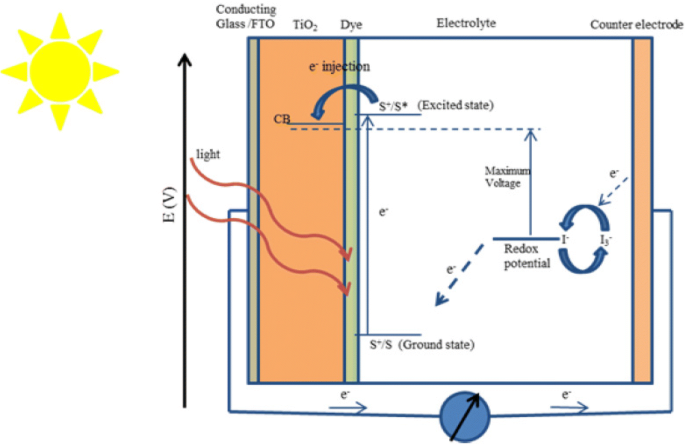
염료감응 태양전지(DSSC)는 pn 접합 광전지 장치에 대한 기술 및 경제적으로 신뢰할 수 있는 대안으로 부상했습니다. 1960년대 후반, 전기화학 전지에서 조명된 유기 염료를 통해 전기가 생성될 수 있다는 것이 발견되었습니다. 캘리포니아 버클리 대학에서는 시금치에서 엽록소를 추출했습니다(광합성). 1972년에 최초로 클로로필 감응 산화아연(ZnO) 전극이 합성되었다. 반도체의 넓은 밴드갭에 들뜬 염료 분자를 처음으로 전자 주입하여 광자를 전기로 변환시켰다[1]. ZnO 단결정[2]에 대해 많은 연구가 수행되었지만 염료 분자의 단층이 입사광을 1%까지만 흡수할 수 있었기 때문에 이러한 염료 감응 태양 전지의 효율은 매우 열악했습니다. 따라서, 미세 산화물 분말로 이루어진 전극의 기공도를 최적화하여 효율을 향상시켜 전극에 대한 염료의 흡수를 향상시키고 결과적으로 광 수확 효율(LHE)도 향상시킬 수 있었다. 그 결과 나노다공성 이산화티타늄(TiO2 ) 거칠기 계수가 약 1000인 전극이 발견되었고 1991년에 7% 효율의 DSSC가 발명되었습니다[3]. Grätzel 세포라고도 알려진 이 세포는 원래 1988년 UC Berkeley의 Brian O'Regan과 Michael Grätzel에 의해 공동 발명되었으며 1991년까지 Ecole Polytechnique Fédèrale de Lausanne(EPFL)의 앞서 언급한 과학자들에 의해 추가로 개발되었습니다.
Brian O'Regan과 Michael Grätzel은 10μm 두께의 높은 표면적과 광학적으로 투명한 TiO2 필름을 기반으로 장치를 제작했습니다. 광 수확을 위해 필름을 민감하게 만들기 위해 이상적인 스펙트럼 특성을 가진 전하 이동 염료의 단층으로 코팅된 나노 입자. 이 장치는 46%의 입사 태양 에너지 플럭스의 높은 비율을 수집했으며 입사 광자를 전류로 변환하는 데 80% 이상의 효율성을 보이는 예외적으로 높은 효율을 보였습니다. 전체 입사 광자-전류 변환 효율(IPCE) 수율은 시뮬레이션된 태양광에서 7.1–7.9%, 확산 일광에서 12%였습니다. 큰 단락 전류 밀도 J SC (12mAcm 초과 − 2 ) 및 탁월한 안정성(분해 없이 최소 500만 회전 유지) 및 저렴한 비용으로 인해 실제 적용이 가능했습니다[3]. 1993년에 Grätzel et al. 9.6%의 전지 효율을 보고했고, 1997년에는 NREL(National Renewable Energy Laboratory)에서 10%를 달성했습니다. 증감제는 일반적으로 -COOH, -PO3와 같은 작용기를 갖도록 설계되었습니다. H2 , 및 –B(OH)2 반도체 기판에 안정적인 흡착을 위해 [4, 5]. 최근 2018년에 Costa et al.에 의해 우수한 저온을 위한 하이브리드 염료-티타니아 나노입자 기반 DSSC에 대해 8.75%의 효율이 보고되었습니다. [6]. 전통적인 태양 전지에서 Si는 두 가지 기능을 제공합니다. 광전자 소스 역할을 하고 전하를 분리하고 전류를 생성하는 전기장을 제공합니다. 그러나 DSSC에서 대부분의 반도체는 전하 수송체로만 사용되며 광전자는 감광성 염료에 의해 제공됩니다. DSSC의 이론적으로 예측된 전력 변환 효율(PCE)은 약 20%였습니다[7, 8]. 따라서 효율성을 개선하고 상업화를 확대하기 위해 DSSC에 대한 광범위한 연구가 수년에 걸쳐 이루어졌습니다. 그러나 지난 수십 년 동안 DSSC의 성능을 향상시키기 위해 많은 실험이 수행되었습니다. 예를 들어, 1920년과 1921년경에 발표된 리뷰 기사나 논문을 살펴보면 이러한 셀의 성능과 제작에서 눈에 띄는 차이가 관찰될 수 있습니다. 이러한 세포의 성능이 어떻게 개선되었고, 따라서 DSSC가 어떻게 연구원들에게 뜨거운 주제가 되었는지에 대한 아이디어를 얻기 위해 각 기사에 표시된 목적 및 주요 결과와 함께 아래에서 몇 가지 검토 논문을 논의합니다.
Anandan은 2007년까지 염료감응 태양전지의 개선점과 발생하는 과제를 검토했습니다[9]. 그의 검토 연구의 주요 구성 요소는 광 수확 무기 염료 분자, p-CuO 나노막대 상대 전극 및 전기 활성 고분자의 자가 조직화였으며 그는 이 재료가 합리적으로 설계된 태양 전지에서 어떻게 작동하는지 보여주었습니다. 그러나 7%의 최대 IPCE는 2007년까지는 좋았지만 이후 작업에서 보여진 효율성의 거의 절반에 불과한 나프티리딘 배위된 Ru 복합체[10]에 대한 검토 논문에서 논의되었습니다.
Bose et al.에 의해 출판된 리뷰 논문의 주요 강조점. [11]은 2015년까지 DSSC용 광전극, 감광제 및 전해질 분야의 현황과 발전이었다. 여기에는 DSSC 모듈의 성능을 Si 기반 모듈의 성능과 비교하는 흥미로운 연구가 포함되어 있다. 그림 1[12]에서 DSSC 모듈의 성능이 Si 모듈의 성능보다 훨씬 낫다는 결론을 내렸습니다. 또한 이 리뷰 논문에서 논의된 최고 효율은 N719 염료 기반 DSSC의 경우 11.2%였습니다.
<그림><그림>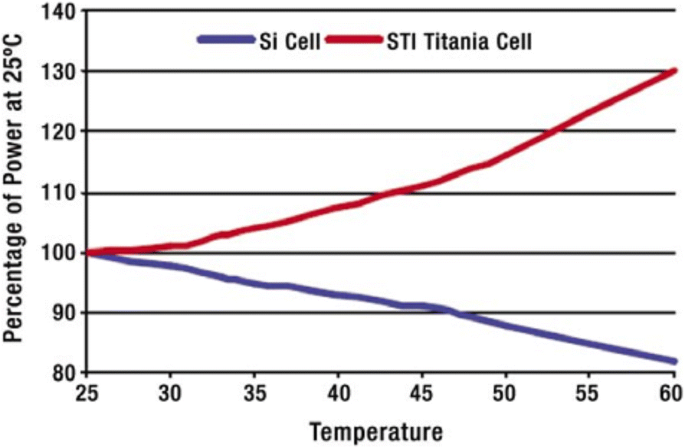
염료 PV 모듈의 성능은 Si 기반 모듈과 달리 온도에 따라 증가합니다[(웹 참조 [http://www.sta.com.au/downloads/DSC%20Booklet.pdf에서 온라인으로 제공] [11, 12]
Shalini et al. [13]은 루테늄 착물, 무금속 유기 염료, 양자점 증감제, 페로브스카이트 기반 증감제, 매염제 염료 및 천연 염료를 포함한 증감제를 강조했습니다. 그러나 이 기사는 다양한 유형의 증감제에 대한 훌륭한 지식을 제공하지만 DSSC의 다른 중요한 구성 요소에 대한 정보는 부족합니다. 다시 말하지만, DSSC의 모든 다른 구성 요소를 논의하는 것 외에도 Jihuai Wu et al.의 리뷰 기사. [14]는 상대 전극 부분에 집중되었다. 그들은 투명성과 유연성, 금속 및 합금, 탄소 재료, 전도성 고분자, 전이 금속 화합물 및 하이브리드에 기반한 다양한 유형의 상대 전극에 대한 연구에 대해 논의했습니다. Au/GNP를 상대 전극으로 사용하여 제작한 DSSC에 대해 14.3%의 최고 효율이 논의되었습니다. Co 3+/2+ 산화 환원 커플로, LEG4 + ADEKA-1은 증감제로 [15] 검토 기사에 표시되었습니다. 유사하게, Yeoh et al. 및 Fan et al. [16, 17]은 DSSC의 광양극에 대해 간략하게 검토했습니다. 그들은 광양극의 개질을 세 가지 범주, 즉 차단 및 산란층의 도입을 통한 계면 개질, 합성, 비금속 음이온 및 금속 양이온으로 도핑, 계면 공학 및 1-과 같은 기존 메조포러스 반도체 금속 산화물 필름 대체로 분류했습니다. D 또는 2D 나노구조.
따라서 이전에 발표된 여러 리뷰 기사를 비교함으로써 본 리뷰 기사 "Dye Sensitized Solar Cells:Fundamentals and Current Status"가 다양한 구성 요소와 DSSC 및 건설 및 이 세포의 작동.
작동 전극, 증감제(염료), 산화환원 매개체(전해질) 및 상대 전극은 DSSC의 4가지 주요 매개변수입니다. DSSC는 증감제 또는 염료로 적셔진 작동 전극의 집합체이며 전해질의 누출을 방지하기 위해 핫멜트 테이프를 사용하여 얇은 층의 전해질로 적신 상대 전극에 밀봉되어 있습니다(그림 2 참조). . 구성 요소와 DSSC의 구성 및 작동은 다음과 같습니다.
<그림><그림>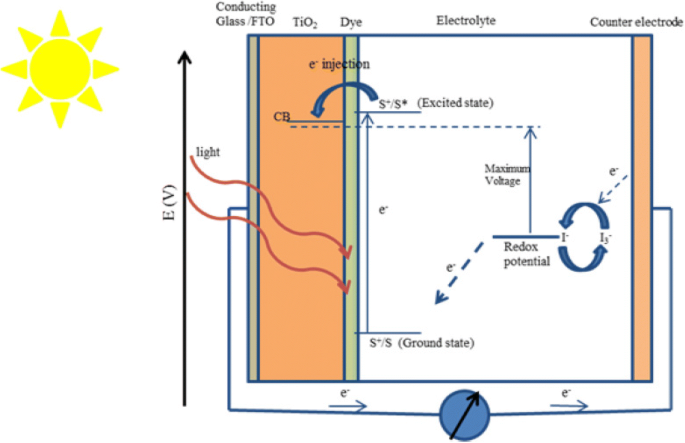
염료감응 나노결정질 태양전지의 구성 및 작동 원리
DSSC는 일반적으로 두 장의 전도성 투명 재료 시트로 구성되며, 이는 반도체 및 촉매 증착을 위한 기판을 돕고 집전체로도 작용합니다. [18, 19] DSSC에 사용되는 기판의 두 가지 주요 특성이 있습니다. , 최적의 햇빛이 세포의 유효 영역으로 통과할 수 있도록 80% 이상의 투명도가 기질에 필요합니다. 둘째, DSSC에서 효율적인 전하 이동과 에너지 손실 감소를 위해서는 높은 전기 전도성을 가져야 합니다. 불소 도핑된 산화주석(FTO, SnO2 :F) 및 인듐 도핑된 산화주석(ITO, In2 O3 :Sn)은 일반적으로 DSSC에서 전도성 기판으로 적용됩니다. 이 기판은 인듐이 도핑된 산화주석과 불소가 도핑된 산화주석 층으로 코팅된 소다석회 유리로 구성됩니다. ITO 필름의 투과율은> 80%이고 18Ω/cm 2 입니다. FTO 필름은 가시 영역에서 ~ 5%의 낮은 투과율과 8.5Ω/cm 2 의 시트 저항을 나타냅니다. [18].
작업 전극(WE)은 TiO2와 같은 산화물 반도체 물질의 얇은 층을 증착하여 준비됩니다. , Nb2 O5 , ZnO, SnO2 (n형), FTO 또는 ITO로 만들어진 투명 전도성 유리판에 NiO(p형). 이러한 산화물은 3~3.2eV의 넓은 에너지 밴드 갭을 가지고 있습니다. TiO2의 아나타제 동소체 형태의 적용 루틸 형태는 3.2eV의 더 높은 에너지 밴드 갭으로 인해 루틸 형태에 비해 DSSC에서 더 칭찬할 만하지만 루틸 형태는 약 3eV의 밴드 갭을 가지지만[20, 21], ZnO 및 Nb와 같은 대안적인 넓은 밴드 갭 산화물 2 O5 또한 유망한 결과를 제공했습니다[22, 23]. 독성이 없고 저렴하며 쉽게 구할 수 있기 때문에 TiO2 주로 반도체 층으로 사용됩니다. 그러나 이러한 반도체 층은 UV 영역에서 아주 작은 부분의 빛만을 흡수합니다. 따라서 이러한 작업 전극은 감광성 분자 증감제와 용매의 혼합물에 담가집니다. 염료 용액에 필름을 담근 후 염료는 TiO2에 공유 결합됩니다. 표면. 다공성 구조와 전극의 넓은 표면적 때문에 나노결정질 TiO2에 많은 수의 염료 분자가 부착됩니다. 따라서 반도체 표면에서 빛의 흡수가 증가합니다.
염료는 입사광의 최대 흡수를 담당하는 DSSC의 구성 요소입니다. 염료가 되는 모든 물질은 다음과 같은 광물리학적 및 전기화학적 특성을 가져야 합니다.
첫째, 염료는 발광해야 합니다.
<리> 2.둘째, 염료의 흡수 스펙트럼은 자외선 가시 영역(UV-vis) 및 근적외선 영역(NIR) 영역을 커버해야 합니다.
<리> 3.가장 높은 점유 분자 궤도(HOMO)는 TiO2의 전도대 표면에서 멀리 떨어져 있어야 합니다. 최저 비점유 분자 궤도(LUMO)는 TiO2 표면에 최대한 가깝게 위치해야 합니다. , 그리고 이후에 TiO2에 대해 더 높아야 합니다. 전도대 잠재력.
<리> 4.HOMO는 산화환원 전해질보다 낮아야 합니다.
<리> 5.염료의 주변부는 전해질과 양극 사이의 직접적인 접촉을 최소화하기 때문에 전지의 장기 안정성을 향상시키기 위해 소수성이어야 합니다. 그렇지 않으면 TiO2에서 염료의 물에 의한 왜곡 표면이 나타날 수 있으며 이는 세포의 안정성을 감소시킬 수 있습니다.
<리> 6.TiO2 위의 염료 응집을 방지하려면 표면, chenodeoxycholic acid(CDCA)와 같은 공동 흡수제와 알콕시-실릴[24], 인산[25] 및 카르복실산 그룹[26, 27]과 같은 고정 그룹이 염료와 TiO2 사이에 삽입되었습니다. 하위> . 이것은 염료 응집을 방지하여 산화 환원 전해질과 TiO2의 전자 사이의 재결합 반응을 제한합니다. 나노층을 형성할 뿐만 아니라 안정적인 결합을 형성합니다.
전해질(예:I − /나 − 3 , 브 − /Br − 2 [29], SCN - /SCN2 [30], Co(II)/Co(III) [31]) 산화환원 커플, 용매, 첨가제, 이온성 액체 및 양이온의 5가지 주요 구성 요소가 있습니다. 전해질에는 다음과 같은 속성이 있어야 합니다.
산화환원 쌍은 산화된 염료를 효율적으로 재생시킬 수 있어야 합니다.
<리> 2.장기적인 화학적, 열적, 전기화학적 안정성을 가져야 합니다.
<리> 3.DSSC 구성 요소와 부식되지 않아야 합니다.
<리> 4.전하 캐리어의 빠른 확산을 허용하고 전도성을 향상시키며 작업 전극과 상대 전극 사이에 효과적인 접촉을 생성할 수 있어야 합니다.
<리> 5.전해질의 흡수 스펙트럼은 염료의 흡수 스펙트럼과 겹치지 않아야 합니다.
나 - /나 − 3 고효율 전해질 [32]로 입증되었지만 DSSC에서의 적용과 관련된 특정 제한 사항이 있습니다. 나 - /나 − 3 전해질은 유리/TiO2를 부식시킵니다. /Pt; 휘발성이 높고 광분해 및 염료 탈착을 담당하며 장기간 안정성이 좋지 않습니다[33, 34]. 아세토니트릴(ACN), N -메틸피롤리딘(NMP) 및 ACN/발레로니트릴과 같은 용매 혼합물이 유전율이 높은 용매로 사용되어 왔다. 4-tert-부틸피리딘(TBP)은 주로 TiO2의 전도대를 이동시키는 첨가제로 사용됩니다. 개방 회로 전압(V OC ), 감소된 세포 광전류(J SC ) 및 더 적은 사출 구동력. TiO2의 TBP는 표면은 전해질로의 역전이를 통해 재조합을 감소시킨다[35]. 그러나 이온성 액체와 관련된 가장 큰 단점은 누출 요인입니다. 따라서 고체 전해질은 이온성 액체(IL) 전해질과 관련된 단점을 피하기 위해 개발되었습니다[36]. 또한, 산화 환원 전해질의 실패 또는 장기간 조명 하에서의 밀봉을 테스트하기 위해 밀봉된 셀에 대한 장기간의 빛 흡수 테스트도 수년에 걸쳐 크게 진행되었습니다[37].
DSSC의 CE는 대부분 백금(Pt) 또는 탄소(C)를 사용하여 제조됩니다. 작동 전극과 상대 전극을 함께 밀봉한 다음 주사기를 사용하여 전해질을 채웁니다. 상대 전극은 I − 의 감소를 촉매합니다. /나 − 3 액체 전해질과 정공 수송 재료(HTM)에서 정공을 수집합니다. Pt는 더 높은 효율을 나타내기 때문에 주로 상대 전극으로 사용되지만[38], Pt는 더 높은 비용과 덜 풍부하기 때문에 Pt의 대체가 많이 필요했습니다. 따라서 탄소[39], 카보닐설파이드(CoS)[40], Au/GNP[15], FeSe와 같은 합금 CE[41] 및 CoNi0.250.25와 같은 DSSC에서 Pt를 대체하기 위해 여러 대안이 개발되었습니다. 하위> [42], 비록 다른 유형의 CE도 Jihuai Wu et al.에 의해 논의되었지만. [14].
DSSC의 작동 원리는 빛 흡수, 전자 주입, 캐리어 수송 및 전류 수집의 4가지 기본 단계를 포함합니다. 다음 단계는 광자를 전류로 변환하는 것과 관련됩니다(그림 2 참조).
첫째, 입사광(광자)은 감광제에 의해 흡수되어 광자 흡수로 인해 전자가 기저상태(S + /S) 여기 상태(S + )로 /S*), 여기서 대부분의 염료에 대한 흡수는 약 1.72eV의 광자 에너지에 해당하는 700nm 범위입니다.
<리> 2.이제 나노세컨드 범위의 수명을 갖는 여기된 전자가 나노다공성 TiO2의 전도대에 주입됩니다. TiO2에서 염료의 여기 상태 아래에 있는 전극 UV 영역에서 태양 광자의 작은 부분을 흡수합니다[43]. 그 결과 염료가 산화됩니다.
$$ {\mathrm{S}}^{+}/\mathrm{S}+\mathrm{h}\upnu \rightarrow {\mathrm{S}}^{+}/{\mathrm{S}}^{ \ast } $$$$ {\mathrm{S}}^{+}/{\mathrm{S}}^{\ast}\rightarrow {\mathrm{S}}^{+}/\mathrm{S} +{\mathrm{e}}^{-}\ \left({\mathrm{TiO}}_2\right) $$ <리> 3.이 주입된 전자는 TiO2 나노 입자 및 후면 접촉쪽으로 확산됩니다(투명 전도성 산화물[TCO]). 외부 회로를 통해 전자는 상대 전극에 도달합니다.
<리> 4.상대 전극의 전자는 I - 을 감소시킵니다. 3 나에게 − ; 따라서 염료 재생 또는 염료 바닥 상태의 재생은 I - 에서 전자의 수용으로 인해 발생합니다. 이온 산화환원 매개체 및 I − I − 으로 산화됩니다. 3 (산화된 상태).
$$ {\mathrm{S}}^{+}/{\mathrm{S}}^{\ast }+{\mathrm{e}}^{-}\rightarrow {\mathrm{S}}^{+ }/\mathrm{S} $$ <리> 5.다시, 산화된 매개체(I - 3 ) 상대 전극 쪽으로 확산되어 I 이온으로 환원됩니다.
$$ {{\mathrm{I}}^{-}}_3+{2\mathrm{e}}^{-}\rightarrow {3\mathrm{I}}^{-} $$염료감응 태양전지의 성능은 입사광자를 전류변환효율(IPCE, %), 단락전류(J SC , mAcm − 2 ), 개방 회로 전압(V OC , V ), 최대 전력 출력 [P 최대 ], 전체 효율성 [η , %] 및 필 팩터 [FF](그림 3 참조)는 Eq. 1 [44].
<그림><그림>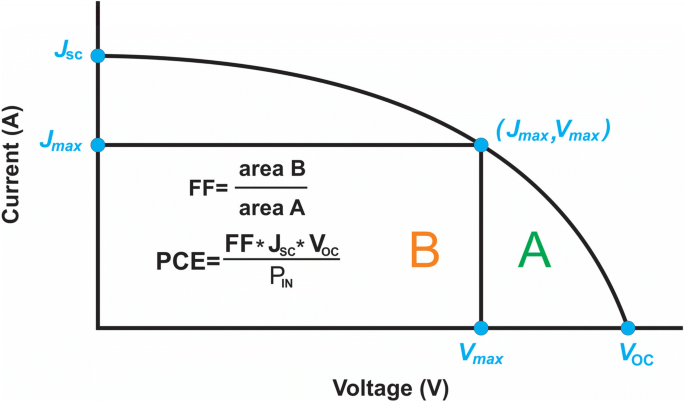
I–V 세포 성능을 평가하는 곡선
전류는 셀의 음극과 양극이 0mV 전압에서 단락될 때 생성됩니다. V OC (V )은 0mA 전류 또는 간단히 반도체 물질의 전도대 에너지와 전해질의 산화환원 전위 사이의 전위차에서 개방 회로 조건 하에서 음극과 양극의 전압입니다. 피 최대 는 태양광을 전기로 변환하는 DSSC의 최대 효율입니다. 최대 출력의 비율(J mp × V mp ) 제품(V OC × J SC ) FF를 제공합니다.
$$ \mathrm{FF}=\frac{\mathrm{면적}\ A}{\mathrm{면적}\ B}=\frac{J_{\mathrm{mp}}\times {V}_{\mathrm{ mp}}}{J_{SC}\times {V}_{OC}} $$또한 전체 효율(%)은 태양 에너지(태양광 [PV] 장치에 비치는)가 전기 에너지로 변환되는 비율입니다. 여기서 ɳ J 값이 감소함에 따라 증가합니다. SC V 값의 증가 OC , FF 및 염료의 몰 계수.
$$ \eta\ \left(\%\right)=\frac{J_{\mathrm{SC}}\times {V}_{\mathrm{OC}}\times \mathrm{FF}}{P_{in }} $$ (1)외부 양자 효율(IPCE라고도 함)은 외부 회로를 통해 흐르는 전자 수와 임의의 파장 λ에서 세포 표면에 입사하는 광자 수의 비율입니다. . 다음과 같이 주어집니다.
$$ \mathrm{IPCE}\%\left(\lambda \right)=1240\times \frac{J_{\mathrm{SC}}}{P_{in}\lambda } $$ (2)IPCE 값은 LHE, φE1 및 ηEC와도 관련이 있습니다. 식과 같이 3 [45],
$$ \mathrm{IPCE}\ \left(\lambda, \mathrm{nm}\right)=\mathrm{LHE}\upvarphi \mathrm{E}1\upeta \mathrm{E}\mathrm{C} $$ (삼)여기서 LHE는 광 수확 효율, φE1은 전자 주입 양자 효율, ηEC는 외부 회로에서 전자를 수집하는 효율입니다.
최근 몇 년 동안 DSSC에 대해 비교 가능한 효율성이 입증되었지만 여전히 이러한 셀과 관련된 일부 제한으로 인해 추가 수정이 필요합니다. 한계 측면에서 안정성 실패는 (i) 외부 안정성에 대한 제한 및 (ii) 고유 안정성에 대한 제한이라는 두 가지 다른 클래스로 특징지을 수 있습니다. 또한, 산화된 염료와 전해질 사이의 에너지 불일치로 인해 재생 과정에서 막대한 양의 산화된 염료 에너지 손실이 발생한다. 따라서 이러한 전지의 효능을 향상시키기 위한 대기열에서 다양한 전해질이 개발되었습니다. Grätzel et al. 900mV 이상의 개방 회로 전압 및 단락 전류 I SC TBP 및 Li[CF3 조합과 정공 도체 매트릭스를 혼합하여 최대 5.1mA SO2 ]2 N, 기단 1.5(AM 1.5) 조명에서 2.56%의 전체 효율을 산출합니다[46]. 또한 FTO 유리판의 면저항은 약 10Ω/sq입니다. 따라서 이는 기기의 크기 조정을 어렵게 만들고 활성 셀 영역> 1 cm 2 에 대한 제한 요소로 작용합니다. . 따라서 시트 저항을 높이고 작업 전극과 상대 전극 사이의 간격을 유지하려면 태양 전지의 단락이 필요하거나 작은 모듈에서 간격을 25~50μm[47] 늘려야 합니다. 활성 셀 영역(1cm 2 )의 작은 줄무늬로 구성 ) 인접한 은색 선 [47, 48]). 결과적으로 1cm 2 의 경우 IPCE 값이 10.4%에서 6.3%로 떨어집니다. 26.5cm 2 의 하위 모듈에서 세포가 관찰되었습니다. [49].
전지 성능을 향상시키기 위해 실버 핑거를 사용하여 전류를 수집하고 전해질 누출로부터 보호하기 위해 핫멜트 테이프와 같은 밀봉재를 사용할 수 있습니다. 전해질의 화학적 공격적 특성으로 인해 실버 핑거의 사용은 실현 가능성이 적습니다. 그리고 작은 모듈로 인해 누출 가능성이 증가하여 활성 셀 영역이 32% 감소합니다[47]. 또 다른 요인은 DSSC의 성능에 영향을 미치는 유리판의 전도성입니다. 따라서 투명 전도성 산화물(TCO)의 전도성은 인듐이 도핑된 산화주석(ITO, 전도성이 높지만 화학적으로 덜 안정적임)과 불소가 도핑된 산화주석(FTO, 화학적으로 안정적이지만 전도성이 낮음)을 함께 결합하여 향상시킬 수 있습니다. . 그 결과 TCO 유리의 시트 저항이 1.3Ω/sq로 감소합니다. [50].
DSSC는 Si 태양전지와 견줄 만큼 내재적으로는 물론 외재적으로도 안정적이어야 시장의 요구를 충족시켜 상용화를 높일 수 있다. 안정성에 대한 제한 사항은 아래에 설명되어 있습니다.
Surlyn® 및 Bynel® 핫멜트 포일과 같은 실런트 재료는 DSSC에서 셀을 밀봉하는 데 사용됩니다[48]. 그들의 밀봉 능력은 압력이 셀 내부에 축적될 때 감소하고[51], 주기적인 또는 규칙적인 온도 변화에 노출되는 경우에도 감소합니다[52]. 그러나 저렴한 비용과 쉬운 처리로 인해 활용도를 무시할 수 없습니다. 따라서 금속산화물 입자로 유리를 전처리하여 유리와의 접착력을 높이는 것이 필요하다. 대안으로, 핫멜트 포일보다 더 높은 안정성을 제공하는 저융점 유리 프릿[53]을 기반으로 하는 실런트도 개발되었지만 이러한 실런트는 대면적 모듈 생산에 적합하지 않습니다.
세포의 고유 안정성을 확인하기 위해 가속 노화 실험을 수행했습니다. 이러한 가속 노화 실험은 1000시간 동안 지속되어 80°C의 온도에서 염료, 전해질, Pt 상대 전극의 열 안정성을 보여줍니다. 이러한 실험을 통해 작은 테스트 셀은 고온에서 초기 효율의 90%를 유지할 수 있으며 관찰된 초기 효율은 각각 7.65%[54]와 8%[55]로 나타났습니다. 또한 AM 1.5 및 55~60°C의 적당한 온도에서 기기가 1000시간 동안 안정적이었습니다. 그러나 두 스트레스 요인, 즉 약 80°C의 온도와 가벼운 담금질이 결합되었을 때 전지 성능의 급격한 저하가 관찰되었습니다[52]. 따라서 맑은 날에는 80°C 온도에 쉽게 도달할 수 있으므로 셀의 고유 안정성 향상이 필요합니다.
DSSC의 효율성과 안정성을 향상시키기 위해 연구자들은 이러한 전지의 작동뿐만 아니라 기본적인 제조 방법 및 재료에 중점을 두어야 합니다. 이러한 태양 전지(SC)의 효율성을 개선하는 다양한 방법은 아래에 설명되어 있습니다.
DSSC의 효율을 높이려면 산화된 염료가 전자 주입 후 원래의 바닥 상태로 단단하게 환원되어야 합니다. 즉, 재생과정(나노초 범위[56])은 염료의 산화과정[재결합과정(0.1~30μs)]에 비해 빨라야 한다. 산화환원 매개체 잠재력(I − 이온)은 최대 광전압에 강한 영향을 미치므로 산화 환원 커플의 전위는 염료의 바닥 상태에 가까워야 합니다. 이 실행 가능한 반복 프로세스를 수행하려면 약 210mV의 구동력(또는 약 0.6V[56])이 필요합니다.
<리> 2.TiO2의 다공성을 증가시켜 나노 입자, 최대 염료 흡수는 WE에서 발생합니다.
<리> 3.TiO2의 균일한 박막 또는 하부층을 증착하여 암전류 형성을 감소 또는 방지 전도성 유리판 위의 나노 입자. 따라서 전해질은 FTO와 직접 접촉하거나 후면 접촉이 없으므로 컬렉터 전자에 의해 환원되지 않아 암전류 형성이 제한됩니다.
<리> 4.나노다공성 TiO2의 포획 방지 TBP 분자 또는 전해질 용매에 의한 나노 입자. 따라서 sensitizer에 의한 WE의 균일한 sensitization이 필요합니다. 나노다공성 TiO2의 전체 표면이 전극이 sensitizer에 의해 균일하게 덮이지 않은 다음 nanoporous TiO2의 노출된 부분 TBP 분자나 전해질 용매에 의해 포획될 수 있습니다.
<리> 5.Co-sensitization은 DSSC의 성능을 최적화하는 또 다른 방법입니다. 동시 증감에서는 흡수 스펙트럼 범위가 다른 두 가지 이상의 증감 염료가 함께 혼합됩니다. 스펙트럼 응답 범위를 넓히기 위해 [57].
<리> 6.나노튜브, 탄소 나노와이어, 그래핀과 같은 전극 제조에 다양한 재료의 사용을 촉진함으로써; 겔 전해질 및 준고체 전해질과 같은 액체 전해질 대신 다양한 전해질 사용; 양극 산화 전처리 및 TiCl4과 같은 작업 전극에 다양한 사전 사후 처리 제공 치료; 다양한 유형의 CE[14]를 사용하고 소수성 증감제를 개발함으로써 이러한 전지의 성능과 효율성을 크게 향상시킬 수 있습니다.
<리> 7.희토류 도핑된 산화물을 DSSC에 적용하는 것과 같은 인광 또는 발광 발색단을 삽입함으로써[58,59,60], 광양극 유리에 발광층을 코팅[60,61,62], 즉 플라즈몬 현상[ 63] 및 전해질에 에너지 릴레이 염료(ERD) 추가 [57, 64, 65].
To fabricate low cost, more flexible, and stable DSSCs with higher efficiencies, new materials that are light weight, thin, low cost, and easy to synthesize are required. Thus, previous as well as further improvement in the field of DSSCs is included in this section. This section gives a brief account on the work done by the different researchers in the last 10–12 years and the results they observed for respective cells.
Grätzel and co-workers showed drastic improvements in the performance of DSSCs. They demonstrated efficiency of 7–10% under AM 1.5 irradiation using nanocrystalline (nc) TiO2 thin-film electrode with nanoporous structure and large surface area, and used a novel Ru bipyridyl complex as a sensitizer and an ionic redox electrolyte at EPFL [3, 26]. The conduction band level of TiO2 electrode and the redox potential of I − /I − 3 as − 0.7 V versus saturated calomel electrode (SCE) and 0.2 V versus SCE has been evaluated [66, 67]. A binary oxide photoelectrode with coffee as a natural dye was demonstrated, in 2014 [68]. SnO2 (x )–ZnO (1 − x ) binary system with two different SnO2 composition (x = 3, 5 mol%) were prepared by solid-state reaction at high temperature and employed as a photoanode. An improved efficiency was demonstrated for the larger SnO2 composition and an overall power conversion efficiency (PCE) observed for SnO2 :ZnO device was increased from 0.18% (3:97 mol%) to 0.26% for a device with SnO2 :ZnO (5:95 mol%) photoanode. Hu et al. observed that the performance of the DSSCs with graphite-P25 composites as photoanodes has been significantly enhanced by 30% improvement of conversion efficiency compared with P25 alone. They found an enhancement in the value of J SC from 9.03 to 12.59 mA/cm 2 under the condition of 0.01 wt% graphite amount and attained the conversion efficiency of 5.76% [69]. Figure 4 shows the SEM images of the photoanodes. Apart from TiO2 , carbon and its different allotropes are also widely applied in DSSCs to fulfill future demand and arisen as a perfect surrogate material for DSSCs. Some reports have shown that incorporating carbon nanotube (CNT) in TiO2 by hydrothermal or sol–gel methods greatly improved the cell’s performance [70,71,72]. Also, by improving the interconnectivity between the TiO2 and CNT, an increase in the IPCE can be found [70]. Sun et al. reported that the DSSCs incorporating graphene in TiO2 photoanode showed a PCE of 4.28%, which was 59% higher than that without graphene [73]. Sharma et al. has shown the improvement in the PCE value from 7.35 to 8.15% of the co-sensitized solar cell using modified TiO2 (G-TiO2 ) photoanode, instead of pure TiO2 photoanode [74]. In 2014, it was shown that the electronically and catalytically functional carbon cloth works as a permeable and flexible counter electrode for DSSC [75]. The researchers have found that the TiN nanotube arrays and TiN nanoparticles supported on carbon nanotubes showed high electrocatalytic activity for the reduction of triiodide ions in DSSCs [76, 77]. Single-crystal CoSe2 nanorods were applied as an efficient electrocatalyst for DSSCs by Sun et al. in 2014 [78]. They prepared single-crystal CoSe2 nanorods with a facile one step hydrothermal method. By drop-casting the CoSe2 nanorod suspension onto conductive substrates followed by simple drying without sintering, they fabricated the thin CoSe2 films and used as a highly efficient electrocatalyst for the reduction of I − 3 . They showed a power conversion efficiency of 10.20% under AM1.5G one-sun illumination for DSSCs with the standard N719 dye. Park et al. prepared a mesoporous TiO2 Bragg stack templated by graft copolymer for dye-sensitized solar cells [79]. To enhance dye loading, electron transport, light harvesting and electrolyte pore-infiltration in DSSCs, they prepared organized mesoporous TiO2 Bragg stacks (om-TiO2 BS) consisting of alternating high and low refractive index organized mesoporous TiO2 (om-TiO2 ) films. They synthesized om-TiO2 films through sol-gel reaction using amphiphilic graft copolymers consisting of poly(vinyl chloride) backbones and poly(oxyethylene methacrylate) side chains, i.e., PVC-g -POEM as templates. They showed that a polymerized ionic liquid (PIL)-based DSSC fabricated with a 1.2-μm-thick om-TiO2 BS-based photoanode exhibited an efficiency of 4.3%, which was much higher than that of conventional DSSCs with a nanocrystalline TiO2 layer (nc-TiO2 layer) with an efficiency of 1.7%. An excellent efficiency of 7.5% was demonstrated for a polymerized ionic liquid (PIL)-based DSSC with a heterostructured photoanode consisting of 400-nm-thick organized mesoporous TiO2 interfacial (om-TiO2 IF) layer, 7-μm-thick nc-TiO2 , and 1.2-μm-thick om-TiO2 BS as the bottom, middle, and top layers, respectively, which was again much higher than that of nanocrystalline TiO2 photoanode with an efficiency of 3.5%. Lee et al. reported platinum-free, low-cost, and flexible DSSCs using graphene film coated with a conducting polymer as a counter electrode [80]. In 2014, Banerjee et al. demonstrated nickel cobalt sulfide nanoneedle-array as an effective alternative to Pt as a counter electrode in dye-sensitized solar cells [81].

a의 SEM 이미지 P25 film, b 1 wt% graphite-P25 composite film, and (c ) the cross section of P25 film on FTO [69]
Calogero et al. invented a transparent and low-cost counter electrode based on platinum nanoparticles prepared by a bottom-up synthetic approach. They demonstrated that with such a type of cathode, the observed solar energy conversion efficiency was the same as that obtained for a platinum-sputtered counter electrode and even was more than 50% obtained with a standard electrode, i.e., one prepared by chlorine platinum acid thermal decomposition, in similar working condition [82]. By using a special back-reflecting layer of silver, they improved upon the performance of a counter electrode based on platinum sputtering and achieved an overall η of 4.75% under 100 mWcm − 2 (AM 1.5) of simulated sunlight. They showed that, for the optical transmittance at different wavelengths of platinum-based films, i.e., Pt nanoparticles, Pt thermal decomposition, and Pt sputtered deposited onto FTO glass, the platinum nanoparticle-based cathode electrode (CE) prepared by Pt sputtering deposition method appeared more transparent than the platinum CE prepared using the Pt acid thermal decomposition method. Meanwhile, when Pt nanoparticle deposition method was employed, the transmittance was very poor (as shown in Fig. 5). Anothumakkool et al. showed a highly conducting 1-D aligned polyethylenedioxythiophene (PEDOT) along the inner and outer surfaces of a hollow carbon nanofiber (CNF), as a counter electrode in a DSSC to enhance the electrocatalytic activity of the cell [83]. They showed that the hybrid material (CP-25) displayed a conversion efficiency of 7.16% compared to 7.30% for the standard Pt counter electrode, 4.48% for bulk PEDOT and 5.56% for CNF, respectively. The enhanced conversion efficiency of CP-25 was accredited to the accomplishment of high conductivity and surface area of PEDOT through the 1-D alignment compared to its bulk counterpart. Further, through a long-term stability test involving efficiency profiling for 20 days, it was observed that CP-25 exhibited extraordinary durability compared to the bulk PEDOT. Recently, Huang et al. improved the performance of the device by inserting a H3 PW12 O40 layer between the transparent conductive oxide layer and the compact TiO2 layer [84]. They observed the reduction in the recombination of the electrons upon the addition of H3 PW12 O40 layer, resulting in longer electron lifetime and obtained a η = 9.3%, respectively.
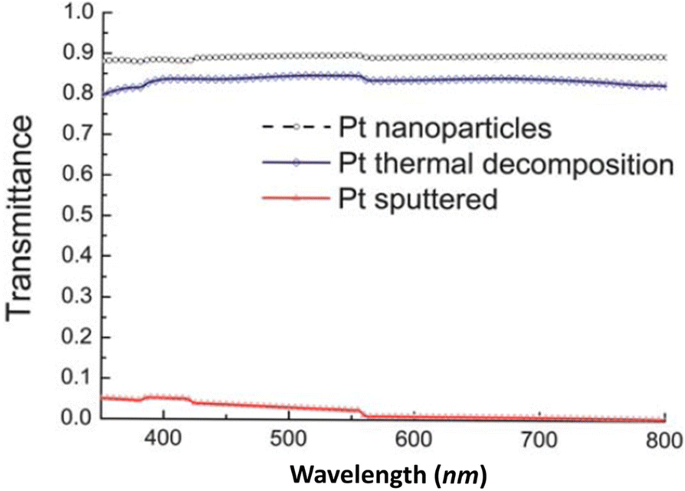
Optical transmittance of platinum-based films (Pt nanoparticles, Pt thermal decomposition, Pt sputtered) deposited onto FTO glass [82]
Li et al. reported that the transition metal nitrides MoN, WN, and Fe2 N show Pt-like electrocatalytic activity for dye-sensitized solar cells, where MoN showed superior electrocatalytic activity and a higher PV performance [85]. Characteristic J–V curves of DSSCs using different metal nitrides and Pt counter electrodes showed that the cell fabricated with the MoN counter electrode achieved a FF = 0.66, which was higher than that of the Pt electrode (as shown in Fig. 6). However, J SC = 11.55 mAcm − 2 was relatively high and the V OC of 0.735 V was almost same to the V OC = 0.740 V offered by Pt electrode. In the case of WN, V OC 및 J SC were relatively low, indicating a low efficiency of 3.67%. DSSC with the Fe2 N electrode attained lower values of V OC and FF, i.e., 0.535 V of V OC and 0.41 of FF, resulting in a poor η = 2.65%. Thus, above data shows superior performance of MoN-based DSSC among all other metal nitrides as CE material. Gokhale et al. showed a laser-synthesized super-hydrophobic conducting carbon with broccoli-type morphology as a CE for dye-sensitized solar cells in 2012 [86]. In 2014, plasmonic light harvesting of dye-sensitized solar cells by Au nanoparticle-loaded TiO2 nanofibers was demonstrated by Naphade et al. [87] because the surface morphology of a WE and a CE play a key role in the performance of DSSC. Usually, mesoporous TiO2 nanoparticle films are used in WE fabrication because they provide large surface area for efficient dye adsorption. However, there are certain limitations associated with them as short electron diffusion length (10–35 μm) and random electrical pathway induced by the substantial trapping and detrapping phenomena that take place within excessive surface states, defects, and grain boundaries of nanoparticles [88] and disorganized stacking of TiO2 films which limits the electron transport [89]. Thus, doping of metallic cations and non-metallic anions in TiO2 , treating FTOs [90], applying 1-D nanostructures like nanowires, nanorods, nanosheets, nanoplates [16], and hollow spheres are approaches to modify the WE. However due to the low surface area, these 1-D nanostructures show poor dye loading. In 2015, Zhao et al. studied the influence of the incorporation of CNT-G-TiO2 NPs into TiO2 NT arrays and attained an efficiency of 6.17% for the DSSC based on CNT-G-TiO2 nanoparticles/TiO2 nanotube double-layer structure photoanode [91]. An efficiency of 8.30% was demonstrated by Qiu et al. for the DSSC based on double-layered anatase TiO2 nanospindle photoanodes [92].
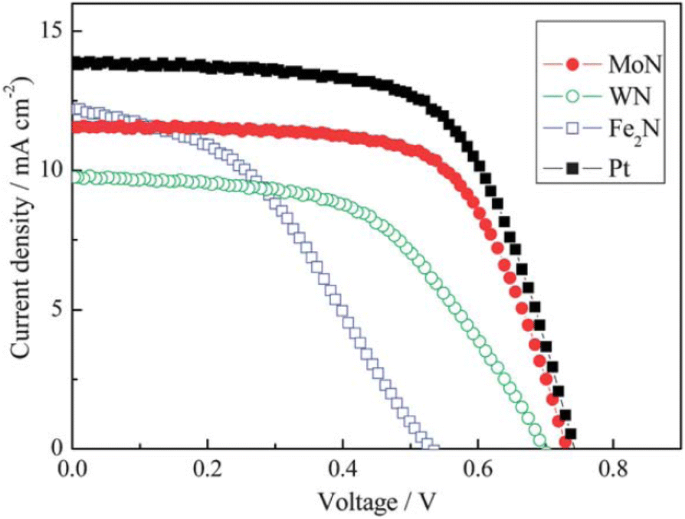
Characteristic J –V curves of DSSCs using different metal nitrides and Pt counter electrodes, measured under simulated sunlight at 100 mWcm − 2 (AM 1.5) [85]
Apart from NTs, bilayer TiO2 hollow spheres/TiO2 nanotube array-based DSSC also showed an effective efficiency of 6.90% [93]. Efficiency can also be improved by incorporating SnO2 as a shell material on a photoanode [94]. The integration of SnO2 as a shell material on ZnO nanoneedle arrays results in a larger surface area and reduced recombination rate [94], thus increasing the dye adsorption which plays a crucial role in the performance of a cell. Huang and co-workers synthesized mesoporous TiO2 spheres of high crystallinity and large surface area and applied it as a WE in the device. An excellent efficiency of 10.3% was achieved for the DSSC-employed TiO2 spheres with long-term stability due to the terrific dye-loading and light-scattering abilities as well as attenuated charge recombination. Further, the efficiency was improved by performing the TiCl4 treatment [95].
Maheswari et al. reported various DSSCs employing zirconia-doped TiO2 nanoparticle and nanowire composite photoanode film. They demonstrated highest η = 9.93% for Zirconia/TNPW photoanode with a hafnium oxide (HfO2 ) blocking layer and observed that the combination of zirconia-doped photoanode with blocking layer possibly restrains the recombination process and increases the PCE of the DSSCs effectively [96]. However, many ideas do not achieve a great efficiency initially but at least embed different ideas and aspects for the synthesis of new materials. For instance, by using carbon-coated stainless steel as a CE for DSSC, Shejale et al. demonstrated a η = 1.98%, respectively [97]. Recently in 2018, a study was carried out to determine the effect of microwave exposure on photoanode and found an enhancement in the efficiency of the cell upon exposure. For the preparation of the DSSC, a LiI electrolyte, Pt cathode, TiO2 photoanode, and Alizarin red as a natural sensitizer were used. An efficiency of 0.144% was found for the cell, where 10 min of microwave exposure was carried upon the photoanode [98].
Similarly, varied materials as mentioned earlier are synthesized as CE for efficient DSSCs. Last year, Guo et al. synthesized an In2.77 S4 @conductive carbon (In2.77S4 @CC) hybrid CE via a two-step method and achieved η = 8.71% for the DSSC with superior electrocatalytic activity for the reduction of triiodide and, also, comparable to the commercial Pt-based DSSC that showed PCE of 8.75%, respectively [99]. The doping of an organic acid, 1S-(+)-camphorsulfonic acid, with the conductive polymer poly(o-methoxyaniline) to form a hybrid (CSA/POMA) and its application in DSSCs as CE has been examined by Tsai et al. This CE showed increased surface roughness, decreased impedance, and increased crystallinity [100]. In 2017, Liu et al. fabricated DSSCs employing Co(bpy)3 3+/2+ as the redox couple and carbon black (CB) as the CE [101]. The observation revealed superior electrocatalytic activity of a well-prepared CB film compared to that of conventional sputtered Pt. Due to the flexible nature of Cu foil substrates, Cu2 O has also been employed as a CE in DSSC [102]. The fabrication of different samples by varying the sintering temperature of the CEs and obtaining the maximum efficiency of 3.62% at 600 °C of temperature has been reported [102]. Figure 7 shows the I –V characteristics and IPCE curves of DSSCs employing different Cu2 O CEs. In 2013, by replacing the FTO with Mo as the conductor for the counter electrode, an increase in the value of FF as well as η was found [103]. The EIS Nyquist plots (as shown in Fig. 8) showed the difference in R s between the devices employed FTO (15.11 Ωcm 2 ) and Mo (7.25 Ωcm 2 ) due to the dissimilarity of the sheet resistance between FTO (8.2 Ω/sq) and Mo (0.16 Ω/sq). Also, by replacing FTO with Mo, a decrease in the R ct1 value from 6.87 to 3.14 Ωcm 2 was induced by the higher redox reactivity of Pt on Mo than that on FTO. In the queue of developing new materials, Maiaugree et al. fabricated DSSCs employing carbonized mangosteen peel (MPC) as a natural counter electrode with a mangosteen peel dye as a sensitizer [104]. They observed a typical mesoporous honeycomb-like carbon structure with a rough nanoscale surface in carbonized mangosteen peels and achieved the highest value of η = 2.63%. By analyzing the Raman spectra (shown in Fig. 9), they found a broad D-peak (130.6 cm − 1 of FWHM) located at 1350 cm − 1 indicating the high disorder of sp3 carbon and a narrower G peak (68.8 cm − 1 of FWHM) at 1595 cm − 1 which correlated with a graphite oxide phase observed in 2008 [105]. Thus, it was concluded the graphite oxide from MPC was a highly ordered sp2 hexagonal carbon oxide network. Furthermore, I–V characteristics of DSSCs employing different WE and CE are summarized in Table 1.
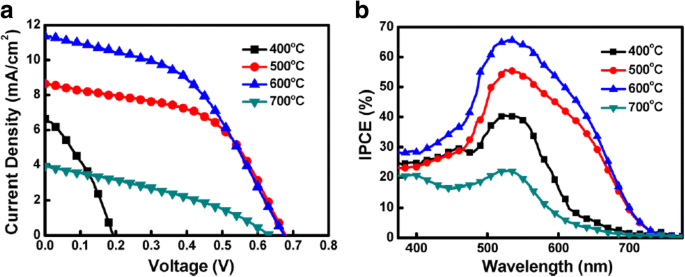
아 current density–voltage (J –V ) and b incident monochromatic photon-to-current conversion efficiency (IPCE) curves of DSSCs using various Cu2 O CE [102]
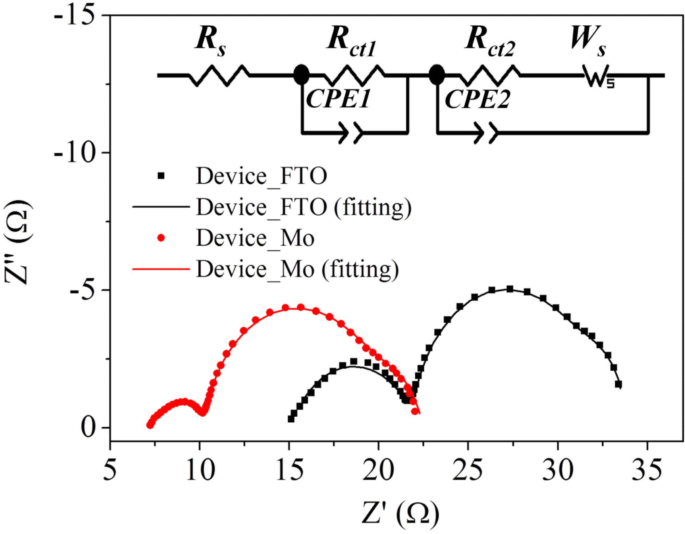
Nyquist plots of the Device_FTO and Device_Mo. The inset indicates an equivalent circuit model used for the devices [103]
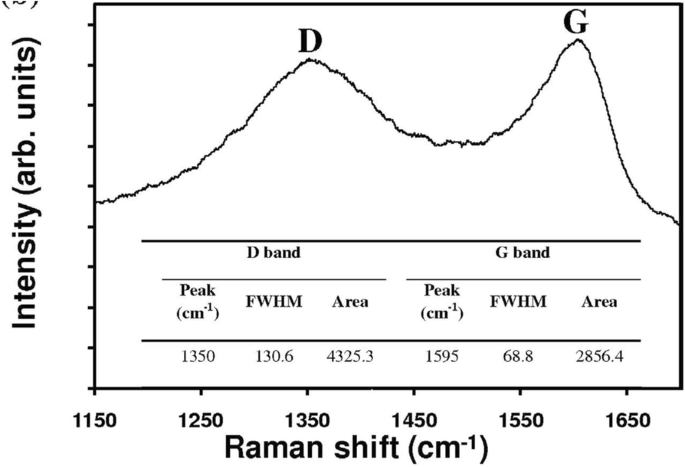
Raman spectra of mangosteen peel carbon [104]
<그림>To improve and study the performance of DSSCs, different electrolytes like gel electrolytes, quasi-solid-state electrolytes, ionic liquid electrolytes etc. have been applied as mediators so far. However, a different trend to optimize the performance of the DSSCs has been initiated by adding the energy relay dyes to the electrolyte.
The cells efficiency through liquid electrolyte can be augmented by introducing iodide/triiodide redox couple and high dielectric constant organic solvents like ACN, 3-methoxypropionitrile (MePN), propylene carbonate (PC), γ-butyrolactone (GBL), N -methyl-2-pyrrolidone (NMP), ethylene carbonate (EC), and counter ions of iodides, where solvents are the key component of a liquid electrolyte. On the basis of their stability, organic solvents can be sequenced as imidazolium
As low-viscous solution can cause leakage in the cell, thus, application of solidified electrolytes obtained by in situ polymerization of precursor solution containing monomer or oligomer and the iodide/iodine redox couple results in a completely filled quasi-solid-state electrolyte within the TiO2 network with negligible vapor pressure [107]. Komiya et al. obtained initial efficiency of 8.1% by applying the aforementioned approach [107]. But still a question arises whether the polymer matrix will degrade under prolonged UV radiations or not. The effect on the addition of SiO2 nanoparticles to solidify the solvent was also studied as to increase the cell efficiency [108], where only inorganic materials were applied in this technique. However, there are certain limitations associated with the addition of organic solvents within a liquid electrolyte, i.e., this leads hermetic sealing of the cell and the evaporation of solvents at higher temperature, and thus the cells do not uphold long-term stability. Therefore, more research was carried over the developments and implementation of gel, polymer, and solid-state electrolytes in the DSSCs with various approaches, such as the usages of the electrolytes containing p-type inorganic semiconductors [109], organic hole transporting materials (HTMs) [110], and polymer gelator (PG) [111]. Chen et al. fabricated a solid-state DSSC using PVB-SPE (polyvinyl butyral-quasi-solid polymeric electrolyte) as an electrolyte. They measured the efficiency approximately 5.46%, which was approximately 94% compared to that of corresponding liquid-state devices, and the lifetime observed for the devices was over 3000 h [112]. Recently, a study explained the stability of the current characteristics of DSSCs in the second quadrant of the I–V characteristics [113]. The study explains the continuous flow of the forward current and the operating voltage point that gradually shift towards more negative voltages in the second quadrant of the I–V characteristics. The increase in the ratio of iodide to tri-iodide in the electrolyte rather than to the decomposition or the coupling reactions of the constituent materials was considered to be the reason behind it. According to the studies, these changes were also considered as reversible reactions that can be detected based on the changes in the color of the electrolyte or the I–V measurements.
However, ILs with lower viscosity and higher iodine concentration are needed as to increase J SC by increasing iodine mass transport. Laser transient measurements have been attempted and revealed that the high iodide concentration present in the pure ILs leads to a reductive quenching of the excited dye molecule [114]. Due to the low cost, thermal stability, and good conductivity of the conductive polymers based on polytiophenes and polypyrroles, they can be widely applied in DSSCs despite using ILs [115]. For the application point of view, the IL should have a high number of delocalized negative charge and counterions with a high chemical stability. Also, the derivatives of imidazolium salts are one of the best applicable in DSSCs. When 1-ethyl-3-methylimidazolium dicyanamide [EMIM] [DCA] with a viscosity of only 21 mPa s [116] was combined with 1-propyl-3-methylimidayolium iodide (PMII, volume ratio 1:1), an efficiency of 7.4% was observed and, after prolonged illumination, some degradation was also found. A cell with a binary IL of 1-ethyl-3-methylimidazolium tetracyanoborate in combination with PMII showed a stable efficiency of 7% that retained at least 90% of its initial efficiency after 1000 h at 80 °C in darkness and 1000 h at 60 °C, at AM 1.5 [117]. Moudam et al. studied the effect of water-based electrolytes in DSSC and demonstrated a highly efficient glass and printable flexible dye-sensitized solar cells upon application [118]. They used high concentrations of alkylamidazoliums to overcome the deleterious effect of water. The DSSCs employed pure water-based electrolyte and were tested under a simulated air mass 1.5 solar spectrum illumination at 100 mWcm − 2 and found the highest recorded efficiency of 3.45% and 6% for flexible and glass cells, respectively. An increase in the value of V OC from 0.38 to 0.72 V on the addition of TBP to the electrolyte has been observed [26]. Thus, to improve the efficiencies of DSSC, new materials were synthesized and applied in DSSCs. L-cysteine/L-cystine redox couple was employed in DSSC by Chen et al. which showed a comparable efficiency of 7.70%, as compared to the cell using I − /나3 - redox couple (8.10%) [119]. In 2016, Huang et al. studied the effect of liquid crystals (LCs) on the PCE of dye-sensitized solar cells. They observed that the addition of minute amounts of LC decreases the J SC because it reduces the electrochemical reaction rate between the counter electrode and an electrolyte. Also, it delays the degradation rates of the cell because of the interaction between cyano groups of the doped LCs and organic solvent in the liquid electrolyte [120]. Main components of different kinds of electrolytes are discussed below:
The improved efficiency for a DSSC can be achieved by adding about 0.5 M of pyridine derivative within the electrolyte, due to which an increase in the value of V OC 발생합니다. This improved V OC can be attributed to the positive band edge movement and slightly affected charge recombination rate on the basis of intensity-modulated photovoltage spectroscopy (IMVS) [121]. The study showed that after the adsorption of pyridine ring on TiO2 surface, the pyridine ring induced electron density into the TiO2 creating a surface dipole. But, the band edge movement results in the slight decrease in J SC as compared to the untreated cell, due to the diminution in the driving force for electron injection [122]. Further, application of NMBI over TBP was studied in 2003, due to its long-term stability under elevated temperature [54].
An improved V OC with slight decrease in the J SC have been observed when DPA [54] and HDMA [123] were combined. This was due to the presence of self-assembled long alkyl chain on the surface of TiO2 , which is responsible for the formation of densely packed hydrophobic monolayer and reduction in recombination rate too, as these long alkyl chains repel iodide from TiO2 surface.
The addition of guanidium thiocyanate as a co-absorbent in an electrolyte results in enhanced V OC by ca. 120 mV with a downward shift in the conduction band by ca. 100 mV [124] at the same time due to the suppression in the recombination rate by a factor of 20 and a difference of 20 mV gained for V OC . By limiting the downward shift in the conduction band, an improvement in the overall efficacy can be attained.
The SSE falls in two subcategories:(1) where hole transport materials are used as a transport medium and (2) SSE containing iodide/triiodide redox couple as a transport medium. Both kinds of SSEs are discussed below:
HTMs fall in the category of solid-state electrolytes, where HTMs are used a medium. These materials have set a great milestone in DSSCs and effectively applicable in cells because iodine/iodide electrolytes are highly chemically aggressive by nature and corrodes other materials easily, mostly metals. Most of the HTMs are chemically less-aggressive inorganic solids, organic polymers, or p-conducting molecules, although the results are still unmatched with the one obtained for iodine/iodide redox electrolytes because of the following reasons:
Due to their solid form, an incomplete penetration of solid HTMs within nanoporous TiO2 -layer leads to poor electronic contact between HTMs and the dye. Thus, incomplete dye regeneration takes place.
The high frequencies of charge recombination from TiO2 to HTMs.
Due to the presence of organic hole conducting molecules, the series resistance of the cell increases due to the low hole mobility in the organic HTMs as compared to IL electrolytes.
HTM results in a drop in V OC , as the recombination rate of electrons of CB with HTM becomes higher as compared to iodine/iodide redox electrolytes.
Low intrinsic conductivities of HTMs.
Thus, researchers need to synthesize and focus on HTMs whose VB energy should be slightly above the energy of the oxidized dye, should not absorb light, and must be photochemically stable, so that they can keep a healthy contact with the dye. Among a number of HTMs, some of the HTMs are discussed below:
CuI halogens and pseudohalogens are two classes of inorganic CuI salts that can be applied as HTMs in a DSSC. Copper bromide (CuBr), copper iodide (CuI), and copper thiocyanate (CuSCN) are some copper-based compounds which work as a hole conductor and are more effective due to their good conductivity. Although CuSCN is one of the best pseudohalogen HTMs and despite its high hole mobility, its application results in high series resistance and does not support high current and also shows poor electronic contact between CuSCN and the dye, and poor pore filling due to their fast crystallization rates, which resulted in low η of < 4% for the corresponding solid-state DSSCs [125]. Thus, to reduce the high recombination rate of electrons, additional blocking layers of insulating materials like SiO2 or Al2 O3 can be applied or coated around the TiO2 particles which enhance the V OC due to the suppressed recombination rate. With respect to halogens, CuBr showed an efficiency of 1.53% with thioether as an additive [126] and demonstrated high stability under prolonged irradiation of about 200 h at RT and the application of nickel oxide (NiO) showed moderate PCEs of 3% [127]. But, due to the easy poor solubility as well as crystallization of these materials, their application became a challenge and, thus, pseudohalogens have proven to be more stable and efficient in DSSCs. But the devices were found to be highly unstable and the reproducibility became dubious.
spiro-OMeTAD {2,2′,7,7′-tetrakis(N,N′-di-p methoxyphenylamine)-9,9′-spirobifluorene} is one of the most suitable candidate in the prospect of hole conducting molecules and thus also widely applicable in integrated devices [128]. It was first introduced in 1998 [110] with a high glass transition temperature of ca. 120 °C. The researchers observed the formation of amorphous layers that are necessary for the complete pore filling and showed an IPCE of 33%, yielding overall efficiency to about 0.74% [110], and finally 4% of efficiency with an ambiphillic dye Z907 was demonstrated [129]. Some other triphenylamine detrivatives also demonstrated sufficient efficiencies in DSSCs [130]. Again, spiro-OMeTAD has certain limitations as it has low charge carrier mobility, ca. 104 cm 2 /Vs [130], that limits the thickness of the TiO2 layer up to 2 μm and thus leads to incomplete light harvesting efficiency (LHE) of dye. Also, a high recombination rate between TiO2 and FTO leads to low efficiencies in DSSCs.
Phenylamines demonstrate a remarkable charge transporting property which makes them great hole transporting materials in organic electroluminescent devices [131]. However, despite a huge range of non-conjugated polymers of di- and triphenylamine which are synthesized and used efficiently as HTMs in organic electroluminescent devices, their conjugated polymers are still rare. Polyaniline (PANI) is the only well-recognized conjugated diphenylamine polymer [132] due to its highly electrical conductive property and is environmentally stable in the doped state. In 1991, triphenylamine (TPA)-conjugated polymers were synthesized by Ni-catalyzed coupling polymerization [133]. Okada et al. reported dimer (TPD 9), trimer (TPTR 10), tetramer (TPTE 11), and pentamer (TPPE 12) of TPA with the aid of Ullmann coupling reaction between the corresponding primary or secondary arylamines and aryl iodides [134].
These SSEs have larger applications than those of HTMs, because interfacial contact properties of these solid-state electrolytes are better than those of HTMs. Fabrication of a DSSC based on solid-state electrolyte was reported by adding TiO2 nanoparticle into poly(ethylene oxide) (PEO) and the overall light-to-electricity conversion efficiency of 4.2% for the cell was obtained under irradiation of AM 1.5100 mWcm − 2 [135].
QSSE has a hybrid network structure, because it consists of a polymer host network swollen with liquid electrolytes, thus showing the property of both solid (cohesive property) and liquid (diffusive transport property), simultaneously. Thus, to overcome the volatilization and leakage problems of liquid electrolytes, ILs like 1-propargyl-3- methylimidazolium iodide, bis(imidazolium) iodides and 1-ethyl-1-methylpyrrolidinium and polymer gel-like PEO, and poly(vinylidinefluoride) and polyvinyl acetate containing redox couples are commonly used as QSSEs [136, 137]. In 2015, Sun et al. fabricated a DSSC employing wet-laid polyethylene terephthalate (PET) membrane electrolyte, where PET is a commonly used textile fiber used in the form of a wet-laid non-woven fabric as a matrix for an electrolyte. According to their observation, this membrane can better absorb electrolyte turning into a quasi-solid, providing excellent interfacial contact between both electrodes of the DSSC and preventing a short circuit. The quasi-solid-state DSSC assembled with an optimized membrane exhibited a PCE = 10.248% at 100 mWcm −2 . To improve the absorbance, they plasma-treated the membrane separately with argon and oxygen, which resulted in the retention of the electrolyte, avoiding its evaporation, and a 15% longer lifetime of the DSSC compared to liquid electrolyte [138]. Figure 10 shows the polarization curves of DSSCs with various electrolytes under simulated AM 1.5 global sunlight (1 Sun, 100 mWcm −2 ).
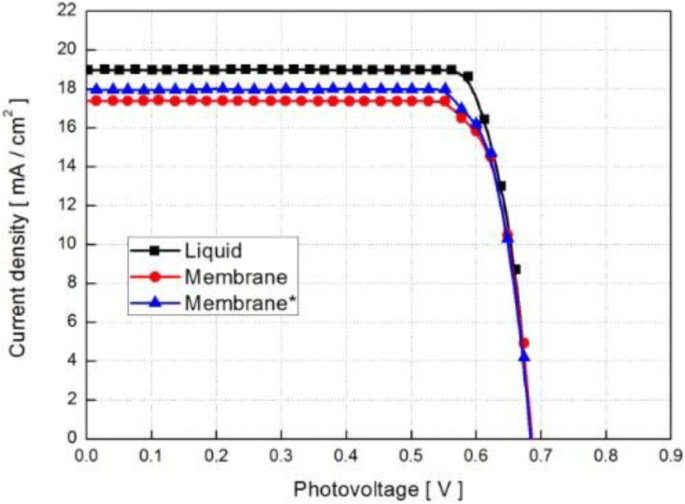
Polarization curves of DSSCs with various electrolytes under simulated AM 1.5 global sunlight (1 sun, 100 mWcm −2 ) [138]
IPCE of 3.5% by the application of C60/polythiphene derivative in DSSCs has been achieved for pure organic solar cells [139]. However, this field is developing slowly, as its deposition by standard methods (like CBD) is difficult, because solid polymer does not penetrate the TiO2 -nanoporous layer. Hence, there are only few groups applied as conducting polymers in DSSCs. Ravirajan et al. demonstrated a monochromatic efficiency of 1.4% at 440 nm by applying fluorene-thiophene copolymer [140]. Researchers are working hard so long to develop new efficient materials for electrolytes. Jeon et al. reported that the addition of alkylpyridinium iodide salts in electrolytes enhanced the performance of the dye-sensitized solar cells. They observed better J–V characteristics, 7.92% efficiency with V OC = 0.696 V, J SC = 17.74 mA/cm 2 , and FF = 0.641 for the cell applying EC6PI (pyridinium salts) as compared to EC3ImI (imidazolium salts), whose η = 7.46% with V OC = 0.686 V, J SC = 16.99 mA/cm 2 , and FF = 0.64 [141]. For a comparison, they added UV spectra for C6ImI and observed that the higher quantum efficiencies from the cell with EC6PI were obtained within the wide range from 460 to 800 nm. The quantum efficiencies were almost the same in the range of shorter wavelengths, may be due to the ability of C6PI to absorb more incident light than C3ImI at shorter wavelengths. Even so, the absorption coefficients for C6PI were higher than those for C6ImI over all the range, but the cell efficiencies are quite comparable (as shown in Fig. 11) [141]. Lee et al. developed and utilized the conjugated polymer electrolytes (CPEs) like MPF-E, MPCZ-E, MPCF-E, and MPCT-E containing quaternized ammonium iodide groups in polymer solution and gel electrolytes for DSSCs. They observed, as the polymer content in the electrolyte solution increased, the electrochemical impedance also increased for the cells based on CPE containing polymer solution electrolytes, whereas the PV performances showed the reverse trend [142]. Table 2 shows the FF and efficiencies for the DSSCs employing various dyes and mediators.
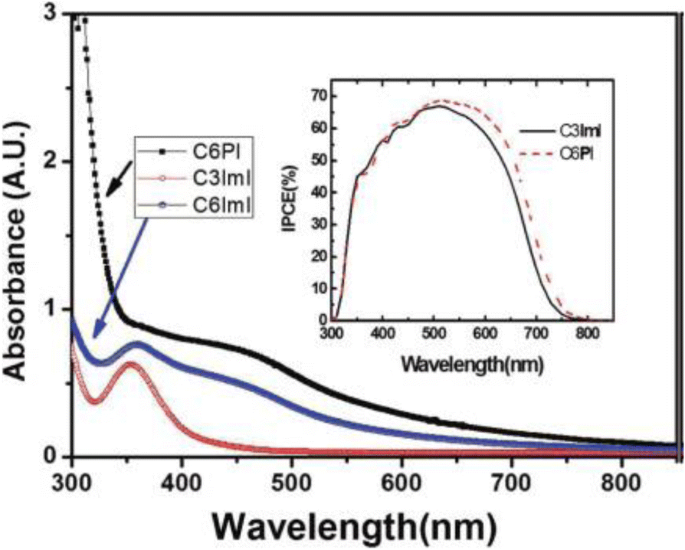
UV-vis spectroscopy selected pyridinium and imidazolium salts. The inset is the IPCE data for the cells with EC3ImI and EC6PI, which are the best cells among each series [141]
<그림>As dyes play a key role in DSSCs, numerous inorganic and organic/metal-free dyes/natural dyes, like N3 [26], N719 [143], N749 (black dye) [144], K19 [145], CYC-B11 [146], C101 [32], K8 [147], D102 [148], SQ [149], Y123 [101], Z907 [150], Mangosteen [106], and many more have been utilized as sensitizers in DSSCs. Few of them will be discussed below briefly:
Metal complex dyes produced from the heavy transition metals such as the complexes of ruthenium (Ru), Osmium (Os), and Iridium (Ir) have widely been used as inorganic dyes in DSSCs because of their long excited lifetime, highly efficient metal-to-ligand charge transfer spectra, and high redox properties. ML2(X)2 is the general structure of the sensitizer preferred as a dye, where M represents a metal, L is a ligand like 2,2′-bipyridyl-4,4′-dicarboxylic acid and X presents a halide, cyanide, thiocyanate, acetyl acetonate, and thiocarbamate or water substituent group [151]. Due to the thermal and chemical stability and wide absorption range from visible to NIR, the ruthenium polypyridyl complexes show best efficiencies and, thus, have been under extensive use so far.
In 1991, O’Regan and Grätzel reported the efficiency of 7.12% for the very first DSSC based on the ruthenium dye (black dye) [3]. Later, an efficiency of about 10% was reported by them using Ru-based dye (N749) which has given this topic a new sight. Most of the Ru complexes consist of Ru(II) atoms coordinated by polypyridyl ligands and thiocyanate moieties in octahedral geometery, and because of the metal to ligand charge transfer (MLCT) transitions, they exhibit moderate absorption coefficient, i.e., < 18,000 M − 1 cm − 1 . Ru (II) complexes lead the inter crossing of excited electron to the long lived triplet state and augmentation in the electron injection. Further, to improve the absorption and emission as well as electrochemical properties of Ru complexes, bipyridyl moieties can be replaced by the carboxylate polypyridine Ru dyes, phosphate Ru dyes, and poly nuclear bipyridyl Ru dyes. Table 3 and Fig. 12 show the molecular structure, the absorption spectra, and photoelectric performance for DSSCs based on different metal complex [polypyridyl (RuII)] dyes.
<그림>In 1993, Nazeeruddin et al. reported DSSC based on Ru-complex dye known as N3 dye {cis-di(thiocyanato)bis(2,2-bipyridine-4,4-dicarboxylate)ruthenium}, which contained one Ru center and two thiocyanate ligands (LL’) with additional carboxylate groups as anchoring sites and absorbed up to 800 nm radiations [26]. They obtained 10.3% efficiency for a system containing N3 dye and treated the dye covered film with TBP. At 518 and 380 nm wavelength, this dye attained maximum absorption spectra with respective extinction coefficients as 1.3 × 10 4 M − 1 cm − 1 and 1.33 × 10 4 M − 1 cm − 1 , 각각. The dye has showed the 60 ns of excited state lifetime and sustained for more than 10 7 turnovers without the significant decomposition since the beginning of the illumination [26]. Further, the absorption of the dye can be extended into the red and NIR by substituting the ligands such as thiocyanate ligands and halogen ligands. For example, a device containing acetylacetonate showed η = 6.0% [152], followed by a pteridinedione complex with 3.8% efficiency [153] and a diimine dithiolate complex with 3.7% efficiency [154].
It has been investigated that during esterification, the dye gets bounded to the TiO2 chemically which results in the partial transformation of protons of the anchoring group to the surface of the TiO2 . Thus, it was concluded that the photovoltaic (PV) performance of the cell gets influenced by the presence of the number of protons on the N3 photosensitizer or, in other words, the modification in protonation level of N3 (N712, N719) affects the performance of the device [155, 156], in two major aspects. Firstly, the increase in the concentration of the protons results in the positively charged TiO2 surface and the downward shift in the Fermi level of TiO2 . Hence, a drop in the V OC takes place due to the positive shift of the conduction band edge induced by the surface protonation. Secondly, the electric field associated with the surface dipole enhances the absorption of the anionic Ru(II) complexes and, thus, insists the electron injection from the excited state of the dye to the conduction band of the TiO2 . In 2001, Nazeeruddin et al. reported a 10.4% of efficiency for the DSSCs using a ruthenium dye, i.e., “black dye” [157], where its wide absorption band covers the entire visible range of wavelengths. Grätzel and group demonstrated the PCE of 9.3% for the monoprotonated sensitizer N3 [TBA]3 closely followed by a diprotonated sensitizer N3[TBA]2 or N719 with a conversion efficiency of 8.4% [156]. Later, Wang et al. and Chiba et al. reported a η = 10.5% [158] and η = 11.1% [159], for the devices that used black dye as a sensitizer in DSSCs.
A new dye “N719” was reported by Nazeeruddin et al. by replacing four H + counterions of N3 dye by three TBA + and one H + counterions and achieved η = 11.2% for the respective device [155]. Despite having almost the same structure to the N3 dye, the higher value of η for N719 was accredited to the change in the counterions, as they altered the speed of adsorption onto the porous TiO2 electrode, i.e., N3 is fast (3 h) whereas N719 is slow (24 h). The dye-sensitized solar cell database (DSSCDB) yields around 329 results assembled from over 250 articles when queried as “N719,” where the reported efficiencies range between 2 and 11% [160].
Recently, Shazly et al. fabricated the solid-state dye-sensitized solar cells based on Zn1-x Snx O nanocomposite photoanodes sensitized with N719 and insinuated with spiro-OMeTAD as a solid hole transport layer [161] and achieved highest efficiency of 4.3% with J SC = 12.45 mAcm − 2 , V OC = 0.740 V, and FF = 46.70. Similarly, by applying different techniques, like post treatment of photoanode, optimizing the thickness of the nc-TiO2 layer, and the antireflective filming, Grätzel group reported η = 11.3% [32] for the device containing the dyes C101 and η = 12.3% [162] for Z991 dye-based DSSCs (molecular structure shown in Fig. 13). Again, if a sensitizer does not carry even a single proton, the value expected for V OC will be high but the value for J SC becomes low. Thus, there should be an optimal amount of protonation of the sensitizer required, so that the product of both J SC 및 V OC can determine the conversion efficiency of the cell as a maximum. And thus, deprotonation levels of N3, N719, and N712 in solar cells were investigated, where the doubly protonated salt form of N3 or N719 showed higher PCE as compared to the other two sensitizers [143]. Figure 14 shows the effect of dye protonation on the I–V characteristics of TiO2 photoanode sensitized with different Ru dyes as N3 (4 protons), N719 (2 protons), N3[TBA]3 (1 proton), and N712 (0 protons) dyes, measured under AM 1.5 [156]. However, the main limitations of N3 sensitizers are their relatively low molar extinction coefficient and less of absorption in the red region of the visible spectrum.
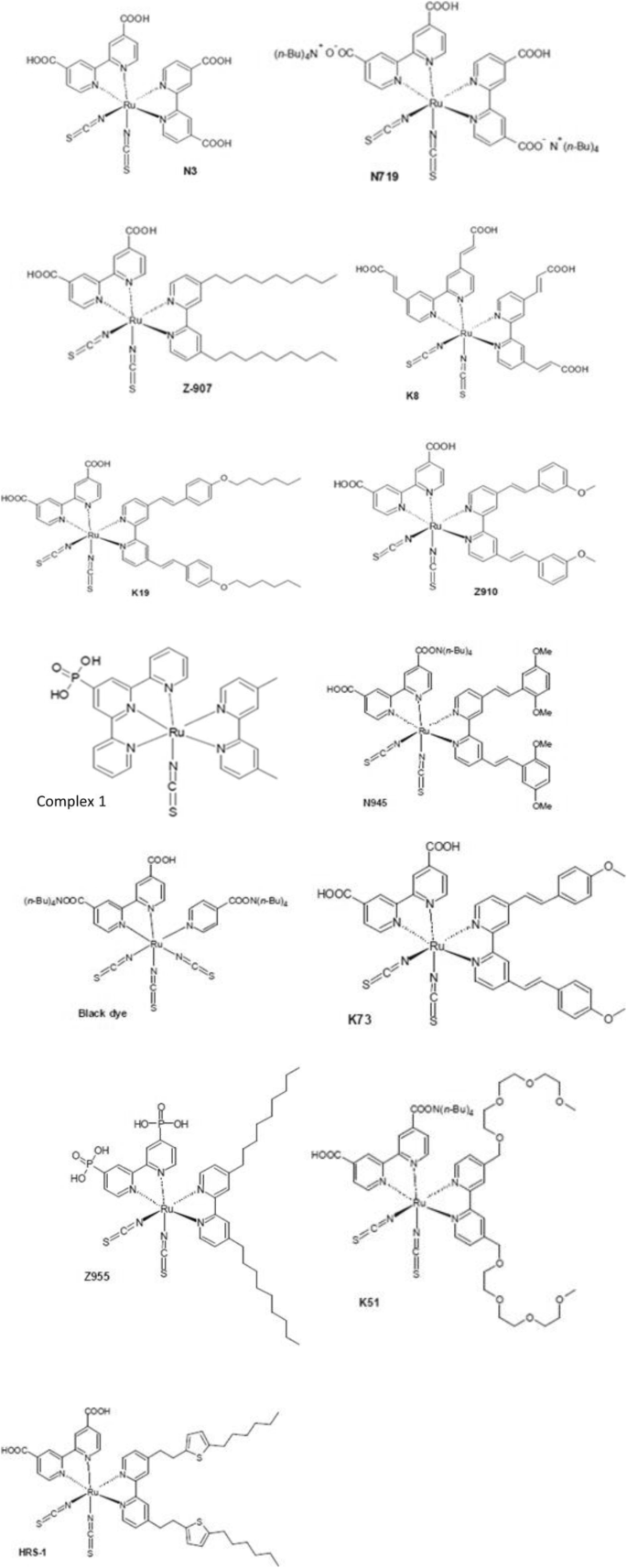
Molecular structure of Ruthenium complex based dye sensitizers
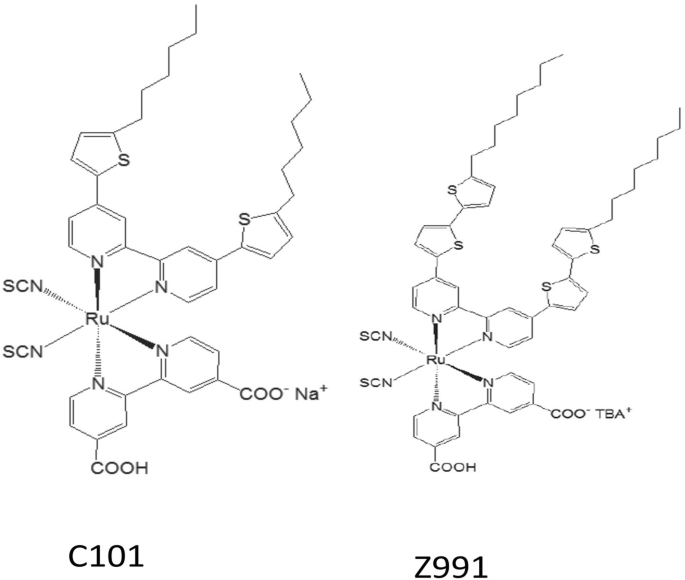
Molecular structure of C101 and Z991 sensitizers
As compared to the other organic dyes, standard Ru complexes have significantly lower absorption coefficient and thus a thick layer of TiO2 was required, which results in the higher electron recombination probability. Thus, two carboxylic acid groups of N3 can be replaced by the ligands containing conjugated π-systems to enhance the absorption and the cell efficiency, simultaneously. Thus, the reason behind the π-system extension in dyes is to create sensitizers with higher molar extinction coefficients (ε ), so that the LUMO of the dye can be tuned to get directionality in the excited state and to introduce hydrophobic side chains that repel water and triiodide from the TiO2 표면. Recently, Rawashdeh et al. have demonstrated an efficiency of 0.45% by modifying the photoanode as graphene-based transparent electrode sensitized with 0.2 mM N749 dye in ethanolic solution [163].
Styryl-ligands attached to the bipyridil ring showed the utmost results. The ε = 1.69 × 10 4 M − 1 cm − 1 for the Z910 dye [164], ε = 1.82 × 10 4 M − 1 cm − 1 for the K19 dye [145], and ε = 1.89 × 10 4 M − 1 cm − 1 for the N945 dye [165] have been found, which were at least 16% more as compared to the standard N3 dye. An efficiency of 10.2% was demonstrated by Wang et al. for Z910 dye [166]. 10.8% of the efficiency was observed for the N945 dye [167] in 2007, on thick electrodes and with volatile electrolytes which was about the same as for the N3 as reference, but, when applied on thin electrodes and with non-volatile electrolytes, the observed PCE was significantly higher. At the same time, a remarkable stability at 80 °C (in darkness) and 60 °C temperature (under AM 1.5) was observed [168], and between − 0.71 V and − 0.79 V vs. normal hydrogen electrode (NHE) [145, 165, 166, 168], the excited state of these dyes has been reported and was observed sufficiently more negative than the conduction band of TiO2 (ca. − 0.1 V vs. NHE) to ensure the complete charge injection. In terms of higher molar extinction coefficient, Nazeeruddin et al. synthesized K8 and K9 dyes that showed even better results as compared to the previous ones. K8 and K9 complexes showed broad and intense absorption bands between 370 and 570 nm. In DMF solution, the K9 complex showed the maxima at 534 nm (λ 최대 ) with a ε = 14,500 M − 1 cm − 1 which was blue shifted by 22 nm compared to K8 complex which showed maxima at 556 nm with a ε = 17,400 M − 1 cm − 1 , 각각. Thus, due to the substitution of 4, 4′-bis (carboxylvinyl)-2, 2′-bipyridine by 4,4′- dinonyl-2,2′-bipyridine, ε observed for K9 complex was ~ 20% less than that of the K8 complex. The overall PCE observed for K8 and K9 complexes were 8.46% with J SC = 18 mA/cm 2 및 V OC = 640 mV and 7.81% with J SC = 16 mA/cm 2 및 V OC = 666 mV [169], respectively. Grätzel group synthesized K19 as a second amphiphilic dye and demonstrated that K19 shows 18,200 M − 1 cm − 1 M extinction coefficient, 7.0% overall conversion efficiency and a low energy metal-to-ligand transition (MLCT) absorption band at 543 nm, which was higher than the corresponding values for the first amphiphilic dye Z907 with a molar extinction coefficient of 12,200 M − 1 cm − 1 , 6.0% overall conversion efficiency, and standard N719 dye with a molar extinction coefficient of 14,000 M − 1 cm − 1 with 6.7% overall PCE under the same fabrication and evaluation conditions. They appraised the performance of the device using N719, Z907, and K19 as sensitizers during thermal aging at 80 °C and observed a lower stability for N719 dye may be due to the desorption of the sensitizer at higher temperature; however, K19 and Z907, both retained over 92% of their initial performances under the thermal stress at 80 °C for 1000 h [145, 169].
Thiophene ligands containing Ru sensitizers also showed good efficiencies. In 2006, Yanagida et al. reported a Ru complex, by replacing a phenylvinyl group of K19 by thienylvinyl group in HRS-1 [170] and an improved stability along with respectable LHE in vis-NIR and a reversible one electron oxidation process was reported. They found a η up to 9.5% for HRS-1 (substituted thiophene derivatives). Several thiophene containing sensitizers have been developed without conjugation, such as C101 [32] and CYC-B1 [171]. After the development of C101 dye, Ru (II) thiophene compounds gained special attention as having set a new DSSC efficiency record of 11.3–11.5% and became the first sensitizer to triumph over the well-known N3 dye [32].
Two of the four carboxylic groups of N3 dye are replaced by long alkyl chains because the ester linkage of the dye to the TiO2 was prone to hydrolyze, if water gets adsorbed on the TiO2 surface [172], thus resulting in usually lower absorption spectrum in these sensitizers due to the smaller conjugated π-system of the bipyridil-ligand. Even though the PCE offered by these sensitizers were appreciable, ranging from 7.3% for Z907 (with 9 carbon atoms) [54] to 9.6% for N621 (with 13 carbon atoms) [155] and were highly stable, Z907 sensitized DSSCs passed 1000 h at 80 °C in darkness and at 55 °C under illumination without any degradation [173]. It has been found that by coadsorption of decylphosphonic acid on the TiO2 NPs, the hydrophobicity of the surface could be even enhanced and, thus, stable cells have been demonstrated [54].
Most of the sensitizers in DSSCs have carboxylic acid groups as an anchor on the surface of TiO2 . But, the dye molecules get desorbed at the semiconductor surface at a pH> 9, due to the shifting of the equilibrium towards the reactant side. Thus, dyes with different anchoring groups are much needed. Again, most of the research focuses on phosphonic acid and the credit goes to its binding strength to a metal oxide surface, as the binding strength to a metal oxide surface decreases in the order, phosphonic acid> carboxylic acid> ester> acid chloride> carboxylate salts> amides [174]. Z955 is a Ru-complex containing phosphonic acid as an anchoring group and demonstrated a η = 8% accompanied by good stability under prolonged light soaking for about 1000 h at AM 1.5 and 55 °C [175]. Triethoxysilane [176] and boronic acid are some other anchoring groups. π-Extended ferrocene with varied anchoring groups (–COOH, –OH, and –CHO) has been applied as photosensitizers in DSSCs [177]. Chauhan and co-workers has synthesized and characterized two new compounds as FcCH=NC6 H4 COOH (1) and FcCH=NCH2 CH2 OH (2), where Fc = C5 H4 FeC5 H5 and FcCHO are used as the starting material [177]. By cyclic voltammetry (CV) in dichloromethane solution and using density functional theory (DFT) calculations, they have explained the quasi-reversible redox behavior of the dyes. The redox-active ferrocenyl group exhibited a single quasi-reversible oxidation wave with E′ = 0.34, 0.44, and 0.44 V for 1, 2, and 3, respectively. In 2017, a study was carried out to inspect the influence of a cyano group in the anchoring part of the dye on its adsorption stability and the overall PV properties like electron injection ability to the surface and V OC [178]. The results indicated that the addition of the cyano group increased the stability of adsorption only when it adsorbs via CN with the surface and it decreased the photovoltaic properties when it was not involved in binding.
However, in the race of improved efficiency and efficient DSSCs, Ru (II) dyes are still an ace. The most vital reason following usage of Ru dyes in DSSCs is their extraordinary stability when being absorbed on the TiO2 표면. N749 and Z907 are the two important Ru dyes, although N749 which shows broad absorption and high efficiency, in contrast, has low absorption coefficient about ~ 7000 M − 1 cm − 1 and the stability of this dye was not so good as compared to other Ru sensitizers. PCE of 10.4% has been observed for black dye, under AM 1.5 and full sunlight [48]. It achieved sensitization over the whole visible range extending into the NIR up to 920 nm with 80% IPCE and 10.4% overall efficiency, when anchored on TiO2 nanocrystalline film. At NREL, black dye (N749)-sensitized DSSC showed efficiency of 10.4% with J SC = 20.53 mA/cm 2 , V OC = 0.721 V, and FF = 0.704, where the active area of the cell was 0.186 cm 2 [157, 179]. Nazeeruddin et al. reported a comparative study between the spectral response of the photocurrent of the two dyes, N3 and N749 [26], as shown in Fig. 15. In the vis-range, both chromophores showed very high IPCE values. The response of N749 dye was observed to be extended 100 nm further into the IR compared to that of N3. The recorded photocurrent onset was close to 920 nm and there on the IPCE rose gradually until at 700 nm it reached to a plateau of ca. 80%. From overlap integral of the curves in Fig. 8 with the AM 1.5 solar emission, it could be predicted that J SC of the N3 and black dye-sensitized cells to be 16 and 20.5 mA/cm 2 , respectively [37]. In Z907 sensitizer, one of the dicarboxy bipyridine ligands in N3 molecule was replaced by a nonyl bipyridine, which resulted in the formation of a hydrophobic environment on the device. However, the dye has set a precedent for hundreds of tris-heteroleptic Ru complexes with isothiocyanate ligands that were developed in the last 15 years, but provides efficiencies rarely comparable to N719 [180].
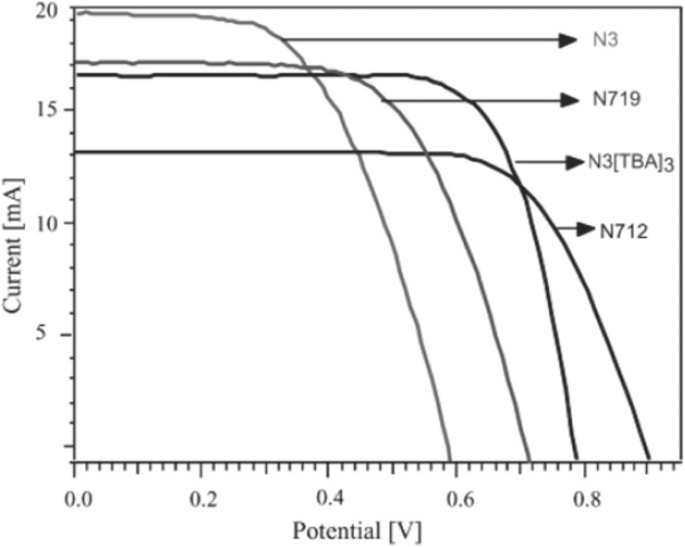
Effect of dye protonation on photocurrent-voltage characteristics of nanocrystalline TiO2 cell sensitized with N3 (4 protons), N719 (2 protons), N3[TBA]3 (1 proton), and N712 (0 protons) dyes, measured under AM 1.5 sun using 1 cm 2 TiO2 electrodes with an I − /나3 - redox couple in methoxyacetonitrile [156]
Despite the capability to provide highly efficient DSSCs, the range of application of Ru dyes are limited to DSSCs, as Ru is a rare and expensive metal and, thus, not suitable for cost-effective, environmentally friendly PV systems. Therefore, development and application of new metal-free/organic dyes and natural dyes is much needed. The efficiency of DSSCs with organic dyes has been increased significantly in the last few years and an efficiency of 9% [181] was shown by Ito and co-workers. The molecular structure and the efficiency for DSSCs based on different metal-free organic dyes are shown in Table 4 and Fig. 16.
<그림>Thus, metal-free organic dyes are developing at a fast pace to overcome the limitations discussed above and especially promising is the fast learning curve, which raises hope of the further synthesis of new materials with higher stability and, thus, designing highly efficient DSSCs at much lower prices. Though the efficiencies offered by these dyes are less comparable to those by Ru dyes, their application is vast as they are potentially very cheap because of the incorporation of rare noble metals in organic dyes; thus, their cost mainly depends on the number of synthesis steps involved. Other advantages associated with organic dyes are their structure variations, low cost, simple preparation process, and environmental friendliness as compared to Ru complexes; also, the absorption coefficient of these organic dyes is typically one order of magnitude higher than Ru complexes which makes the thin TiO2 layer feasible. Thus, there is a huge demand to develop new pure organic dyes, so that the commercialization of DSSCs becomes easier.
However, there are certain limitations associated with these dyes too, as under high elevated temperatures the observed stability of the organic dyes were not as good as expected. Therefore, to get a larger photocurrent response for newly designed and developed organic dyes, it is essential to attain predominant light-harvesting abilities in the whole visible region and NIR of dyes, with a sufficiently positive HOMO than I − /I − 3 redox potential and sufficiently negative LUMO than the conduction band edge level of the TiO2 semiconductor, respectively [182, 183]. In 2008, Tian et al. fabricated DSSCs based on a novel dye (2TPA-R), containing two triphenylamine (TPA) units connected by a vinyl group and rhodanine-3-acetic acid as the electron acceptor to study the intramolecular energy transfer (En T) and charge transfer (ICT) [184]. They found that the intramolecular En T and ICT processes showed a positive effect on the performance of DSSCs, but the less amount of dye was adsorbed on TiO2 which may make it difficult to improve the efficiency of DSSCs [184]. An efficiency of 2.3% was attained for the DSSC used 2TPA-R dye and an imidazolium iodide electrolyte, whereas η = 2% was achieved for TPA-R dye. This improved efficiency for 2TPA-R device was possibly due to the contribution of the En T and ICT. They studied the effect of 2TPA-R via absorption spectrum (as shown in Fig. 17) and found that the two absorption bands, i.e., λ abs at 383 nm and 485 nm obtained for 2TPA-R, are almost the same as those observed for 2TPA (λ abs at 388 nm) and TPA-R (λ abs at 476 nm) in CH2 Cl2 solution (2 × 10 − 5 M). Thus, the study on intramolecular En T and ICT could help in the design and synthesis of efficient organic dyes. Hence, a suitable anchoring group which can chemically bind over the TiO2 surface with a suitable structure and effective intramolecular En T and ICT processes, is also required for synthesis.
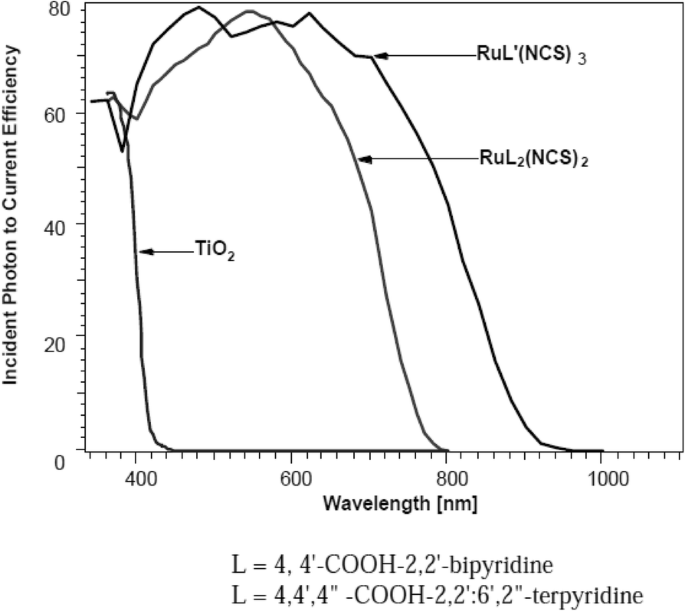
Photocurrent action spectra obtained with the N3 (ligand L) and the black dye (ligand L_) as sensitizer. The photocurrent response of bare TiO 2 films is also shown for comparison [26]
The construction of most of the organic dyes is based on the donor- acceptor (D-A)-like structure linked through a π-conjugated bridge (D–π–A) and usually has a rod-like configuration. Moieties like indoline, triarylamine, coumarin, and fluorine are employed as an electron donor unit, whereas carboxylic acid, cyanoacrylic acid, and rhodamine units are best applicable as electron acceptors to fulfill the requirement. The linking of donor and acceptor is brought about by adding π spacer such as polyene and oligothiophene [185, 186]. This type of the structure results in a higher photoinduced electron transfer from the donor to acceptor through linker (spacer) to the conduction band of the TiO2 layer, where the π-conjugation can be extended either by increasing the methine unit or by introducing aromatic rings such as benzene, thiophene, and furan or in other words by adding either electron donating or withdrawing groups, which results in the enhanced light harvesting ability of the dye, and by using different donor, linker, and acceptor groups, the photophysical properties of the organic dyes can also be tuned [187, 188]. Whereas the photophysical properties change with the expansion of π-conjugation due to the shift of the both HOMO and LUMO energy levels, thus, D–π–A structure was considered to be the most promising class of organic dyes in DSSCs as they can be easily tuned [189]. Moreover, in 2010, the encouraging efficiency up to 10.3% was reported using organic dyes [190]. Fuse et al. demonstrated a one-pot procedure to clarify the structure–property relationships of donor–π–acceptor dyes for DSSCs through rapid library synthesis [191]. Four novel organic dyes IDB-1, ISB-1, IDB-2, and ISB-2, based on 5-phenyl-iminodibenzyl (IDB) and 5-phenyliminostlbene (ISB) as electron donors and cyanoacrylic acid moiety as an electron acceptor connected with a thiophene as a π-conjugated system, were designed by Wang et al. in 2012 [192]. The highest efficiencies for the devices based on ISB-2 were observed due to the larger red shifts of 48 nm for ISB-2, indicating the more powerful electron-donating ability due to the increased linker conjugation. The absorption peaks for IDB-1, ISB-1, IDB-2, and ISB-2 were obtained at 422, 470, 467, and 498 nm in dichloromethane-diluted solution, respectively.
Tetrahydroquinolines [193, 194], pyrolidine [195], diphenylamine [196], triphenylamine (TPA) [27, 197], coumarin [198, 199], indoline [200, 201], fluorine [202], carbazole (CBZ) [203], phenothiazine (PTZ) [204, 205], phenoxazine (POZ) [206], hemicyanine dyes [207], merocyanine dyes [208], squaraine dyes [209], perylene dyes [210], anthraquinone dyes [211], boradiazaindacene (BODIPY) dyes [212], oligothiophene dyes [213], and polymeric dyes [214] are widely used in DSSCs and are still under development. Jia et al. designed quasi-solid-state DSSCs employing two efficient sensitizers FNE55 and FNE56, based on fluorinated quinoxaline moiety, i.e., 6, 7-difluoroquinoxaline moiety, and an organic dye FNE54 without fluorine was designed for comparison [215]. From the studies, it was concluded that the absorption properties of the dye enhanced bathochromically from 504 nm for FNE54 to 511 nm and 525 nm for FNE55 and FNE56 sensitizers upon the addition of fluorine into the dye. The addition of fluorine resulted in the improved electron-withdrawing ability of the quinoxaline and, thus, enhanced the push–pull interactions and narrowed the energy band gap. Due to the high polarizability, spectroscopically and electrochemically tunable properties and high chemical stability, π-conjugated oligothiophenes were well applied as spacers in DSSCs [194, 204]. To induce a bathochromic shift and augment the absorption, a number of thiophene units could be increased in the spacers, and by controlling the length of these thiophene units or chain, higher efficiencies up to two to three units can be achieved [216, 217], as the π-conjugated spacers used previously were thiophenes linked directly or through double bonds to the donor moiety [218].
As good electron injection is one of the parameters for higher efficiency in the DSSCs, cyanoacetic acid and cyanoacrylic acid are well employed as acceptor units due to their strong electron withdrawing capability. Yu et al. concluded cyanoacrylic acid as a strong electron acceptor for D–π–A-based dyes because the dye incorporating cyanoacrylic acid as an electron acceptor showed the best results and, due to the maximum absorption spectrum and the highest molar excitation coefficient, the DSSC achieved η = 4.93% [219]. Wang and co-workers designed organic dyes based on thienothiophene as π conjugation unit, where they used triphenylamine as donor and cyanoacetic acid as an acceptor. They substituted different alkyl chains on the triphenylamine unit and found the best efficiency of about 7.05% for the sensitizers with longer alkoxy chains due to the longer electron lifetime [220]. Acceptors based on rhodanine-3-acetic acid were also used as an alternative, but due to the low lying molecular LUMO, the results obtained were not pleasing [221, 222].
Coumarin is a synthetic organic dye and is a natural compound found in many plants like tonka bean, woodruff, and bison grass (molecular structure shown in Fig. 18a). In 1996, Grätzel et al. found the efficient electron injection rates of 200 fs from C343 into the conduction band of the TiO2 , where for the first time the transient studies on a coumarin dye in DSSCs were performed [223]. But the narrow absorption spectrum of C343, i.e., lack of absorption in the visible region, resulted in the lower conversion efficiency of the device. This can be altered by adding more methane groups that result in expanding the π-conjugation linkers and an increased efficiency of the DSSC [224]. Giribabu and co-workers synthesized RD-Cou sensitizers and obtained the conversion efficiency of 4.24% using liquid electrolyte, where coumarin moiety was bridged to the pyridyl groups by thiophene, which resulted in the extended π-conjugation and broadening of the metal-to-ligand charge transfer spectra [225]. They found that the absorption spectrum of RD-Cou dye was centered at 498 nm with a ɛ = 16,046 M − 1 cm − 1 . Despite the lower efficiency offered by these cells, the thermal stability of the sensitizer make its rooftop applications possible because the dye showed stability of up to 220 °C during thermal analysis.
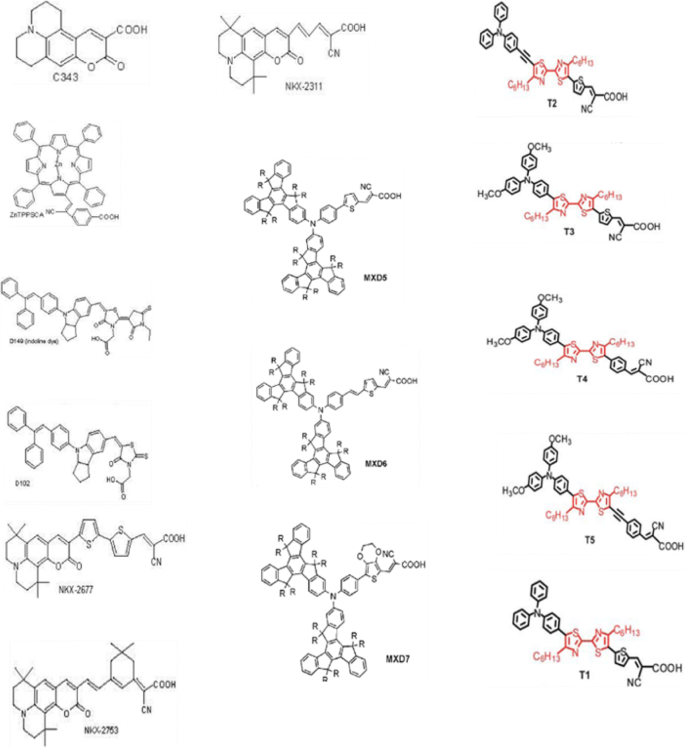
Molecular Structure of metal-free organic dyes
Indole occurs naturally as a building block in amino acid tryptophan, and in many alkaloids and dyes too (molecular structure shown in Fig. 18b). It is substituted with an electron withdrawing anchoring group on the benzene ring and an electron donating group on the nitrogen atom, and these dyes have demonstrated good potential as a sensitizer. Generally, the D–A structure of an indole dye is such that the indole moiety acts as an electron donor and is connected to a rhodanine group that acts as an electron acceptor. Also by introducing the aromatic units into the core of the indoline structure, the absorbance in the infrared (IR) region of the visible spectra as well as the absorption coefficient of the dye can be enhanced significantly [226]. An efficiency of 6.1% was demonstrated for DSSCs with D102 dye, and by optimizing the substituents, 8% of the efficiency was attained with D149 dye [200]. Another dye “D205” was synthesized by controlling the aggregation between the dye molecules, as an indoline dye with an n-octyl substituent on the rhodanine ring of D149 [227]. They investigated that n-octyl substitution increased the V OC without acknowledging the presence of CDCA too much. However, the increase in the V OC of D205 due to the CDCA was approximately 0.054 V but showed little effect on D149 with an increase of 0.006 V only. But the CDCA and n-octyl chain (D205) together improved the V OC by up to 0.710 V significantly, which was 0.066 V higher (by 10.2%) than that of D149 with CDCA.
Further in 2012, η = 9.4% was shown by Wu et al. with the observed J SC = 18 mAcm − 2 , V OC = 0.69 V, and FF = 0.78, by employing indoline as an organic dye in the respective DSSC [228]. Suzuka et al. fabricated a DSSC sensitized with indoline dyes in conjunction with the highly reactive but robust nitroxide radical molecules as redox mediator in a quasi-solid gel form of the electrolyte. They obtained an appreciable efficacy of 10.1% at 1 sun. To suppress a charge-recombination process at the dye interface, they introduced long alkyl chains, which specifically interact with the radical mediator [229]. Recently in 2017, Irgashev et al. synthesized a novel push-pull thieno[2,3-b]indole-based metal-free dyes and investigated their application in DSSCs [230]. They designed IK 3–6 dyes based on the thieno[2,3-b]indole ring system, bearing various aliphatic substituents such as the nitrogen atom as an electron-donating part, several thiophene units as a π-bridge linker, and 2-cyanoacrylic acid as the electron-accepting and anchoring group. An efficiency of 6.3% was achieved for the DSSCs employing 2-cyano-3-{5-[8-(2-ethylhexyl)-8H-thieno[2,3-b]indol-2-yl]thiophen-2-yl}acrylic acid (IK 3), under simulated AM 1.5 G irradiation (100 mWcm − 2 ), whereas the lower values of η = 1.3% and 1.4%, respectively, were shown by the dyes IK 5 and IK 6. The LUMO energy levels are more negative than the conduction edge of the TiO2 (− 3.9 eV), and their HOMO energy levels of all four dyes were found to be more positive than the I − /나3 - redox couple (− 4.9 eV), making possible regeneration of oxidized dye molecules after injection of excited electrons into TiO2 electrode (as shown in Fig. 19) [230]. The less efficiency of other dyes was contributed by the intermolecular π-stacking and aggregation processes in these dyes, proceeding on the photoanode surface.
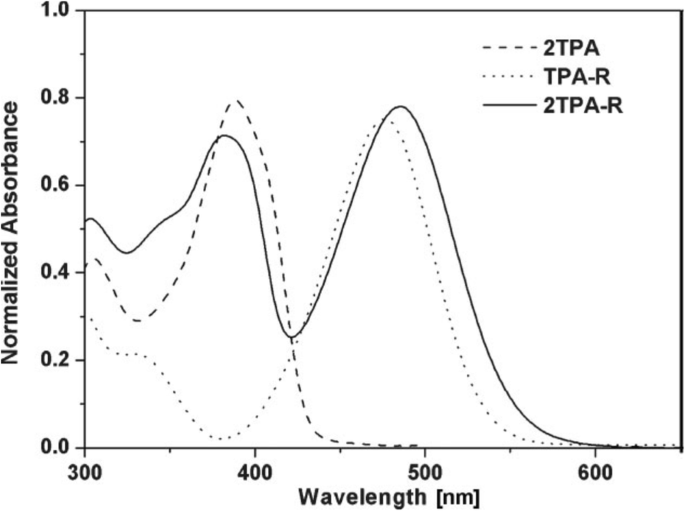
Absorption spectra of 2TPA, TPA-R, and 2TPA-R in CH2 Cl2 solutions [184]
Porphyrin shows strong absorption and emission in the visible region and has a long lifetime in its excited singlet state (> 1 ns), very fast electron injection rate (femtosecond range) [231], millisecond time scale electron recombination rate [232], and tunable redox potentials [13]. In 1987, the first paper was published on DSSCs based on efficient sensitization of TiO2 with porphyrins [233]. This led researchers in the direction to make efforts for the synthesis of novel porphyrin derivatives with the underlying idea to mimic nature’s photosystems I and II, so that the large molar extinction coefficient of the Soret bands and Q bands can be exploited. In 2007, a Zn-porphyrin dye-based DSSC was fabricated by Campbell et al. and has given the exceptional PCE of 7.1% [195]. Krishna and co-workers investigated the application of bulky nature phenanthroimidazole-based porphyrin sensitizers in DSSCs [234]. The group designed a novel D–π–A-based porphyrin sensitizer having strong electron-donating methyl phenanthroimidazole ring and ethynylcarboxyphenyl group at meso-position of porphyrin framework (LG11). They have attached the hexyl phenyl chains to the phenanthroimidazole moiety to reduce the unwanted loss of V OC caused by dye aggregation and charge recombination effect, thus achieving an increase in V OC to 460 and 650 mV. The energy level diagram and the absorption–emission spectra for the sensitizers (LG11-14) are shown in Fig. 20 [234].
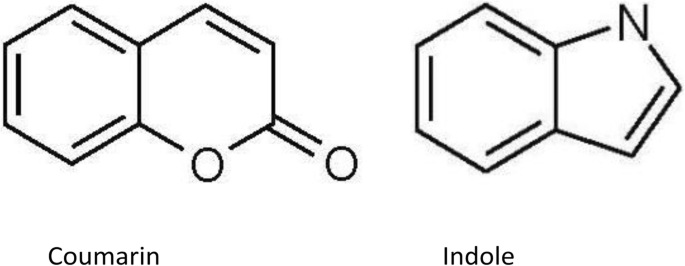
Molecular structure of a Coumarin and b indole
Wang et al. have synthesized zinc porphyrins in a series bearing a phenylethynyl, naphthalenylethynyl, anthracenylethynyl, phenanthrenylethynyl, or pyrenylethynyl substituent, namely LD1, LD2, LD3a, LD3p, and LD4, as photosensitizers for DSSCs (as shown in Fig. 21). The overall efficiencies of the corresponding devices resulted as LD4 (with η = 10.06%) > LD3p > LD2 > LD3a > LD1. The higher value of η 및 V OC = 0.711 V was achieved for LD4 due to the broader and more red-shifted spectral feature; thus, the IPCE spectrum was covered broadly over the entire visible region [235]. Later for a push–pull zinc porphyrin DSSCs, changes in the structural design were carried out and structures with long alkoxyl chains enveloping the porphyrin core were built. By following the process, a η = 12.3% was achieved by Yella et al. for DSSC with cobalt as the mediator [236].
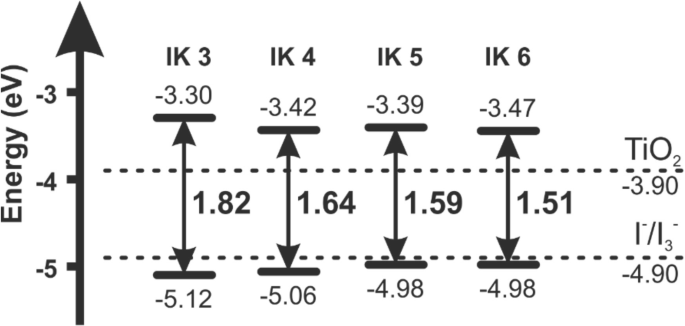
HOMO and LUMO energy level diagram of dyes IK 3–6 [230]
Giovannetti et al. investigated the free base, Cu(II) and Zn(II) complexes of the 2,7,12,17-tetrapropionic acid of 3,8,13,18-tetramethyl-21H,23H porphyrin (CPI) in solution and bounded to transparent monolayer TiO2 nanoparticle films to determine their adsorption on the TiO2 surface, to measure the adsorption kinetics and isotherms, and to use the obtained results to optimize the preparation of DSSC PVCs (photovoltaic cells) [237]. The absorption spectra study of CPI, CPIZn, and CPICu molecules onto the TiO2 surface (as shown in Fig. 22) revealed the presence of typical strong Soret and weak Q bands of porphyrin molecules in the region 400–450 nm and 500–650 nm, which were not changed with respect to the solution spectra. They observed no modification in the structural properties of the adsorbed molecules.
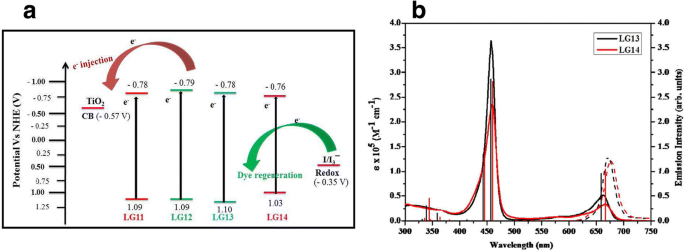
Energy level diagram of LG-11 to LG-14 porphyrins, electrolyte and TiO2 (아 ) and absorption (left, solid line) and emission (right, dashed line) spectra of porphyrin sensitizers LG-13 and LG-14 in the THF solvent (b )
Due to the good electron as well as transporting capability and its special propeller starburst molecular structure with a nonplanar configuration, the triarylamine group is widely applied as a HTM in various electronic devices. Triarylamine derivative distributes the π–π stacking and, thus, improves the cells performance by reducing the charge recombination, minimizing the dye aggregation and enhancing the molar extinction coefficient of the organic dye [202, 217, 238]. By the addition of alkyl chains or donating groups, the structural modification of the triarylamine derivatives could be performed [218, 220, 239]. The performance of a basic D–π–A organic dye can be improved by simply binding donor substitutions on the π-linker of the dye [240]. Thus, Prachumrak and co-workers have synthesized three new molecularly engineered D–π–A dyes, namely T2–4, comprising TPA as a donor, terthiophene containing different numbers of TPA substitutions as a π-conjugated linker and cyanoacrylic acid as an acceptor [240]. To minimize the electron recombination between redox electrolyte and the TiO2 surface as well as an increase the electron correction efficiency, the introduction of electron donating TPA substitutes on the π-linker of the D–π–A dye can play a favorable game, leading to improved V OC 및 J SC , respectively [240]. In 2006, Hagberg et al. published a paper on TPA-based D5 dye [241], where the overall PCE demonstrated for D5 dye was 5.1% in comparison with the standard N719 dye with an efficiency of 6.40% under the similar fabrication conditions. Thus, D5 appeared as an underpinning structure to design the next series of TPA derivatives.
In 2007, a series L0-L4 of TPA-based organic dyes were published by extending the conjugation in a systematic way [218]. By increasing the π conjugation, the absorption spectra and molar extinction coefficients of L0-L4 were increased. The observed IPCE spectra for L0 and L1 dyes were high, but the spectra of these dyes were not broad; as a result, lower conversion efficiencies were obtained for L0 and L1, whereas the broad absorption spectrum as well as the broad IPCE was obtained for L3 and L4 by the augmentation of linker conjugation, but the efficiencies observed were less than the L0 and L1 due to the amount of dye loading, i.e., with the increase in the size of dye there appears a decrease in the dye amount. Thus, the lower IPCE obtained for longer L3 and L4 may be accredited to unfavorable binding with the TiO2 표면. Higher efficiencies were obtained for solar cells based on L1 and L2, 2.75% and 3.08%, respectively. Baheti et al. synthesized DSSCs based on nanocrystalline anatase TiO2 and simple triarylamine-based dyes containing fluorene and biphenyl linkers [242]. They reported that the fluorene-based dyes showed better solar cell parameters than those of the biphenyl analogues. In 2011, Lu et al. reported the synthesis and photophysical/electrochemical properties of three functional triarylamine organic dyes (MXD5-7) as well as their application in dye-sensitized solar cells. They used the nonplanar structures of bishexapropyltruxeneamino as an electron donor [243] and investigated the impact of addition of chenodeoxycholic acid (CDCA) in the respective dyes, as MXD5-7 without CDCA showed lower photocurrent and efficiency as compared to the dyes MXD5-7 with 3 mM CDCA. However, the highest efficiency of 6.18% was observed for MXD7 (with 3 mM CDCA) with electron lifetime (τ ) = 63 ms, under standard global AM 1.5 solar conditions (molecular structure is given in Table 4, where R = propyl).
Using furan as a linker, different TPA-based chromophores were studied by Lin and co-workers [244]. When D5 and its furan counterpart were compared, the results were exciting, still the light harvesting abilities observed for D5 were higher (λ abs = 476 nm with ε = 45,900 M − 1 cm − 1 in ACN) than those for the furan counterpart (λ abs = 439 nm with ε = 33,000 M − 1 cm − 1 in ACN). However, the performance of the solar cells based on the furan counterpart (ɳmax = 7.36%) was better as compared to the one based on D5 (ɳmax = 6.09%) because of the faster recombination lifetimes in D5. Again, the tendency of trapping of charge from the TPA moeity was higher in thiophene than the furan. In 2016, Simon et al. reported an enhancement in the photovoltage for DSSCs that employed triarylamine-based dyes, where halogen-bonding interactions existed between a nucleophilic electrolyte species (I − ) and a photo-oxidized dye immobilized on a TiO2 표면. They found larger rate constants for dye regeneration (k 등록 ) by the nucleophilic electrolyte species when heavier halogen substituents were positioned on the dye. Through the observations, they concluded that the halogen-bonding interactions between the dye and the electrolyte can boost the performance of DSSC [245]. However, the most efficient metal-free organic dye-based DSSC has shown PCE of 10.3% in combination with a cobalt redox shuttle, by using the phenyl dihexyloxy-substituted triphenylamine (TPA) (DHO-TPA) Y123 dye [246]. In 2018, Manfredi and group have designed di-branched dyes based on a triphenylamino (TPA) donor core with different aromatic and heteroaromatic peripheral groups bonded to TPA as auxiliary donors [247]. Thus, due to the improved strategic interface interactions between the dye sensitized titania and the liquid electrolyte, better optical properties were achieved.
Phenothiazine is a heterocyclic compound containing electron-rich sulfur and nitrogen heteroatoms, with a non-planar and butterfly conformation in the ground state, which can obstruct the molecular aggregation and the intermolecular excimer formation. Thus, PTZ results as a promising hole transport semiconductor in the organic devices, presenting unique electronic and optical properties [248].
Tian and co-workers investigated the effect of PTZ as an electron-donating unit in DSSCs, and because of the stronger electron donating tendency of PTZ unit than the TPA unit (0.848 and 1.04 V vs. the normal hydrogen electrode (NHE), respectively) [249], they found efficient results for the sensitizers based on PTZ rather than those based on the TPA [250]. In 2007, a new series of PTZ-based dyes as T2–1 to T2–4 was demonstrated [251]. In these dyes, PTZ unit acted as an electron donor, cyanoacrylic acid or rhodanine-3-acetic acid was used as an electron acceptor, and alkyl chains were used to increase the solubility. They found a red shift in the absorption spectra of T2–3 (η = 1.9%) and T2–4 (η = 2.4%) dyes with low IPCE values for rhodanine-3-acetic acid as an anchoring group, as compared to T2–1 (η = 5.5%) and T2–2 (η = 4.8%) dyes with cyanoacrylic acid as an anchoring group. This proved the use of the cyanoacrylic acid is more viable than a rhodanine-3-acetic acid. In 2010, Tian et al. reported modified phenothiazine (P1-P3) dyes [252] with the molecular structure containing the same acceptor and conjugation chain but different donors. Due to the presence of two methoxy groups attached to TPA, a red shift was observed in the absorption spectra of P1 as compared to P2 and P3. This resulted in an increment in the extent of electron delocalization over the whole molecule and, thus, a little red shift in the maximum absorption peak was observed. Xie et al. synthesized two novel organic dyes (PTZ-1 and PTZ-2) using electron-rich phenothiazine as electron donors and oligothiophene vinylene as conjugation spacers. They employed 13 μm transparent and 1.5 μm scattering TiO2 electrode and used an electrolyte composed of 0.6 M butylmethylimidazolium iodide (BMII), 0.03 M I2 , 0.1 M GuSCN, 0.5 M 4-tert-butylpyridine in acetonitrile (TBP in ACN), and valeronitrile. They demonstrated that the (2E)-2-cyano-3-(5-(5-((E)-2-(10-(2-ethylhexyl)-10H-phenothiazin-7-yl)vinyl)thiophen-2-yl)thiophen-2-yl)acrylic acid (PTZ-1) and (2E)-3-(5-(5-(4,5-bis((E)-2-(10-(2-ethylhexyl)-10Hphenothiazin-3-yl)vinyl)thiophen-2-yl)thiophen-2-yl)thiophen-2-yl)-2cyanoacrylic acid (PTZ-2)-based DSSC showed V OC = 0.70 V, J SC = 11.69 mAcm − 2 , FF = 65.3, and η = 5.4% and V OC = 0.706 V, J SC = 7.14 mAcm − 2 , FF = 55.6, and η = 2.80% [150] under AM 1.5100 mWcm −2 illumination, respectively. The effect of hydrophilic sensitizer PTZ-TEG together with an aqueous choline chloride-based deep eutectic solvent (used as an electrolyte) has been reported [253]. In the study, glucuronic acid (GA) was used as a co-absorbent because it as has a simple structure and polar nature and is also able to better interact with hydrophilic media and components and possibly participates to the hydrogen bind interaction operated in the DES medium. PCE of 0.50% was achieved for the 1:1 dye/coabsorbent ratio.
It is a non-planar compound and can improve the hole transporting ability of the materials as well as avert the dye aggregate formation [235]. Due to its unique optical, electrical, and chemical properties, this compound has been applied as an active component in solar cells [254, 255]. Even with the addition of carbazole unit into the structure, the thermal stability and glassy state durability of the organic molecules were observed to be improved significantly [256, 257]. Tian et al. reported an efficiency of 6.02% for the DSSCs using S4 dye as a sensitizer, with an additional carbazole moiety to the outside of the donor group and found that the additional moiety facilitated the charge separation thereby decreasing the recombination rate between conduction band electrons and the oxidized sensitizer [185].
A series of MK-1, MK-2, and MK-3 dyes based on carbazole were reported by Koumura et al., where MK-1 and MK-2 have alkyl groups but MK-3 had no alkyl group. They showed that the presence of alkyl groups increased the electron lifetime and consequently V OC in MK-1 and MK-2 [203, 258, 259], and due to the absence of alkyl groups, lower electron lifetime values could be responsible for the recombination process between the conduction band electrons and dye cations in MK-3. New structured dyes, i.e., D–A–π–A-type and D–D–π–A-type organic dyes, have been developed by inserting the subordinate donor–acceptor such as 3,6-ditert-butylcarbazole-2,3-diphenylquinoxaline to facilitate electron migration, restrain dye aggregation, and improve photostability [260]. Thus, by further extending the π conjugation of the linkers, mounting the electron-donating and electron-accepting capability of donors and acceptors, and substituting long alkyl chains, more stable DSSCs with lower dye aggregation and higher efficiency can be achieved.
Phenoxazine is a tricyclic isoster of PTZ. The PTZ and POZ units display a stronger electron donating ability than the TPA unit (0.848, 0.880, and 1.04 V vs. normal hydrogen electrode (NHE), respectively) [261]. However, DSSCs based on POZ dyes show better cell performance as compared to PTZ dye-based DSSCs [261]. In 2009, two POZ-based dyes were demonstrated by Tian et al., i.e., a simple POZ dye TH301 and triphenylamine attached to TH301, named as TH305. Due to the insertion of TPA unit in TH305, a red shift in the absorption band was seen because of the higher electron donating capability of POZ. The efficiencies obtained for TH301 and TH305 were 6.2% and 7.7%, respectively, where standard N719 sensitizer showed an efficiency of 8.0% under similar conditions [206]. Thus, in 2011, Karslson reported a series of dyes MP03, MK05, MK08, MK12, and MK13, based on POZ unit, to increase the absorption properties of the sensitizers [261]. Further, two novel metal-free dyes (DPP-I and DPP-II) with a diketopyrrolopyrrole (DPP) core were synthesized for dye-sensitized solar cells (DSSCs) by Qu et al. [262]. They demonstrated the better photovoltaic performance with a maximum monochromatic IPCE of 80% and η = 4.14% with J SC = 9.78 mAcm − 2 , V OC = 605 mV, and FF = 0.69, for the DSSC based on dye DPP-I.
Singh et al. have demonstrated nanocrystalline TiO2 dye-sensitized solar cells with PCE of 4.47% successfully designed two metal-free dyes (TPA–CN1–R2 and TPA–CN2–R1), containing triphenylamine and cyanovinylene 4-nitrophenyls as donors and carboxylic acid as an acceptor [263].
Semiconductor quantum dots (QDs) are another attractive approach to being sensitizers. These are II–VI and III–V type semiconductor particles whose size is small enough to produce quantum confinement effects. QD is a fluorescent semiconductor nanocrystal or nanoparticle typically between 10 and 100 atoms in diameter and confines the motion of electrons in conduction band, holes in valence band, or simply excitons in all three spatial directions. Thus, by changing the size of the particle, the absorption spectrum of such QDs can be easily varied. An efficiency of 7.0% has been recorded by collaborating groups from the University of Toronto and EPFL [264]. This recorded efficiency was higher than the solid-state DSSCs and lower than the DSSCs based on liquid electrolytes. A high performance QDSSC with 4.2% of PCE was demonstrated by Li et al. This cell consisted of TiO2 /CuInS2 -QDs/CdS/ZnS photoanode, a polysulfide electrolyte, and a CuS counter electrode [265]. In 2014, a conversion efficiency of 8.55% has been reported by Chuang et al. [266]. Recently, Saad and co-workers investigated the influence on the absorbance peak on N719 dye due to the combination between cadmium selenide (CdSe) QDs and zinc sulfide (ZnS) QDs [267]. The cyclic voltammetry (CV) of varying wt% of ZnS found that the 40 wt% of ZnS is an apposite combination for a DSSC’s photoanode and has produced the higher current. However, 50 wt% of ZnS was found to be the best concerto to increase the absorbance peak of the photoanode.
New dye materials are also under extensive research, due to the intrinsic properties of Ru(II)-based dyes, and as a result to replace these rare and expensive Ru(II) complexes, the cheaper and environmentally friendly natural dyes overcome as an alternative [268].
Natural dyes provide low-cost and environmentally friendly DSSCs. There are various natural dyes containing anthocyanin [268], chlorophyll [269], flavonoid [270], carotenoid [271], etc. which have been used as sensitizers in DSSCs. Table 5 provides the general characteristics of these dyes, i.e., their availability and color range.
<그림>Anthocyanin :The molecular structure of anthocyanin is shown in Fig. 23a. In anthocyanin molecule, the carbonyl and hydroxyl groups are bound to the semiconductor (TiO2 ) surface, which stimulates the electron transfer from the sensitizer (anthocyanin molecules) to the conduction band of porous semiconducting (TiO2 ) film. Anthocyanin can absorb light and transfer that light energy by resonance energy transfers to the anthocyanin pair in the reaction center of the photosystems [272].

Molecular structures of LD porphyrins
Flavonoid :Flavonoid is an enormous compilation of natural dyes which shows a carbon framework (C6 –C3 –C6 ) or more particularly the phenylbenzopyran functionality, as shown in Fig. 23b [273]. It contains 15 carbons with two phenyl rings connected by three carbon bridges, forming a third ring, where the different colors of flavonoids depend on the degree of phenyl ring oxidation (C-ring). Its adsorption onto mesoporous TiO2 surface is quite fast by displacing an OH counter ion from the Ti sites that combines with a proton donated by the flavonoid [274].
Carotenoid :Andanthocyanin, flavonoids, and carotenoids are often found in the same organs [275]. Carotenoids are the compounds having eight isoprenoid units that are widespread in nature (as shown in Fig. 23c). Beta-carotene dye has an absorbance in wavelength zones from 415 to 508 nm, has the largest photoconductivity of 8.2 × 10 − 4 and 28.3 × 10 − 4 (Ω.m) − 1 in dark and bright conditions [276], and has great potential as energy harvesters and sensitizers for DSSCs [277].
Cholorophyll: Among six different types of chlorophyll pigments that actually exist, Chl α is the most occurring type. Its molecular structure comprises a chlorine ring with a Mg center, along with different side chains and a hydrocarbon trail, depending on the Chl type (as shown in Fig. 23d).
In 1997, antocyanins extracted from blackberries gave a conversion efficiency of 0.56% [268]. The roselle (Hibiscus sabdariffa containing anthocyanin) flowers and papaw (Carica papaya containing chlorophyll) leaves were also investigated as natural sensitizers for DSSCs. Eli et al. sensitized TiO2 photoelectrode with roselle extract (η = 0.046%) and papaw leaves (η = 0.022%), respectively and found better efficiency for roselle extract-sensitized cell because of the broader absorption of the roselle extract onto TiO2 [278]. Tannins have also been attracted as a sensitizer in DSSCs due to their photochemical stability. DSSCs using natural dyes tannins and other polyphenols (extracted from Ceylon black tea) have given photocurrents of up to 8 mAcm − 2 [168]. Haryanto et al. fabricated a DSSC using annato seeds (Bixa orellana Linn ) as a sensitizer [279]. They demonstrated V OC 및 J SC for 30 g, 40 g, and 50 g as 0.4000 V, 0.4251 V, and 0.4502 V and 0.000074 A, 0.000458 A, and 0.000857 A, respectively. The efficiencies of the fabricated solar cells using annato seeds as a sensitizer for each varying mass were 0.00799%, 0.01237%, and 0.05696%. They observed 328–515 nm wavelength range for annato seeds with the help of a UV-vis spectrometer. Hemalatha et al. reported a PCE of 0.22% for the Kerria japonica carotenoid dye-sensitized solar cells in 2012 [280].
In 2017, a paper was published on DSSCs sensitized with four natural dyes (viz. Indian jamun, plum, black currant, and berries). The cell achieved highest PCE of 0.55% and 0.53%, respectively, for anthocyanin extracts of blackcurrant and mixed berry juice [281]. Flavonoid dye extracted from Botuje (Jathopha curcas Linn ) has been used a sensitizer in DSSCs. Boyo et al. achieved η = 0.12% with the J SC = 0.69 mAcm − 2 , V OC = 0.054 V, and FF = 0.87 for the flavonoid dye-sensitized solar cell [282]. Bougainvillea and bottlebrush flower can also be used as a sensitizer in DSSCs because both of them show a good absorption level in the range of 400 to 600 nm as a sensitizer, with peak absorption at 520 nm for bougainvillea and 510 nm for bottlebrush flower [283]. A study of color stability of anthocyanin (mangosteen pericarp) with co-pigmentation method has been conducted by Munawaroh et al. They have found higher color retention for anthocyanin-malic acid and anthocyanin-ascorbic acid than that of pure anthocyanin [284]. Thus, the addition of ascorbic acid and malic acid as a co-pigment can be performed to protect the color retention of anthocyanin (mangosteen pericarp) from the degradation process. 나 –V characteristics of DSSCs employing different natural dyes are shown in Table 6.
<그림>Os, Fe and Pt complexes [285, 286, 287] are considered to be some other promising materials in DSSCs. Besides the fact that Os complexes are highly toxic, they are applied as a sensitizer in DSSCs due to its intense absorption (α811nm = 1.5 × 103 M− 1 cm− 1) and for the utilization of spin forbidden singlet-triplet MLCT transition in the NIR. Higher IPCE values were obtained in this spectral region; however, the overall conversion efficiency was only 50% of a standard Ru dye. Pt complexes have given modest efficiencies of ca. 0.64% [286] a and iron complexes, which are very interesting due to the vast abundance of the metal and its non-toxicity; the solvatochromism of complexes like [FeIIL2(CN)2] can be used to adjust their ground and excited state potentials and increase the driving force for electron injection into the semiconductor conduction band or for regeneration of the oxidized dye by the electrolyte couple [287].
Thus, a number of metal dyes, metal-free organic dyes, and natural dyes have been synthesized till today. Many other dyes like K51 [288], K60 [289], K68 [290]; D5, D6 (containing oligophenylenevinylene π-conjugated backbones, each with one N ,N -dibutylamino moiety) [291]; K77 [292]; SJW-E1 [293]; S8 [294]; JK91 and JK92 [295]; CBTR, CfBTR, CiPoR, CifPoR, and CifPR [296, 297]; Complexes A1, A2, and A3 [298]; T18 [299]; A597 [300]; YS-1–YS-5 [301]; YE05 [302]; and TFRS-1–3 [303] were developed and applied as sensitizers in DSSCs.
However, a different trend to optimize the performance of the DSSCs has been started by adding the energy relay dyes (ERDs) to the electrolyte [57, 304]; inserting phosphorescence or luminescent chromophores, such as applying rare-earth doped oxides [58,59,60] into the DSSC; and coating a luminescent layer on the glass of the photoanode [61, 62]. In the process of adding the ERDs to the electrolyte or to the HTM, some highly luminescent fluorophores have to be chosen. The main role of ERD molecules in DSSCs is to absorb the light that is not in the primary absorption spectrum range of the sensitizing dye and then transfer the energy non-radiatively to the sensitizing dyes by the fluorescence (Forster) resonance energy transfer (FRET) effect [305]. An improvement in the external quantum efficiency of 5 to 10% in the spectrum range from 400 to 500 nm has been demonstrated by Siegers and colleagues [306]. Recently, Lin et al. reported the doping of 1,8-naphthalimide (N-Bu) derivative fluorophore directly into a TiO2 mesoporous film with N719 for application in DSSCs [307], in which the N-Bu functioned as the FRET donor and transferred the energy via spectral down-conversion to the N719 molecules (FRET acceptor). An improvement of the PCE from 7.63 to 8.13% under 1 sun (AM 1.5) illumination was attained by the cell. Similarly, Prathiwi et al. fabricated a DSSC by adding a synthetic dye into the natural dye containing anthocyanin (from red cabbage) in 2017 [308]. They prepared two different dyes at different volumes, i.e., anthocyanin dye at a volume of 10 ml and combination dyes at a volume of 8 ml (anthocyanin):2 ml (N719 synthetic dye), respectively. They observed an enhancement in conversion efficiency up to 125%, because individually the anthocyanin dye achieved a conversion efficiency of 0.024% whereas for the combination dye 0.054% conversion efficiency was achieved. This enhancement was considered due to the higher light absorption. Thus, greater photon absorption took place and the electrons in excited state were also increased to enhance the photocurrent. Thus, cocktail dyes are also developing as a new trend in DSSCs. Chang et al. achieved a η = 1.47% when chlorophyll dye (from wormwood) and anthocyanin dye (from purple cabbage) as natural dyes were mixed together at volume ratio of 1:1 [309], whereas the individual dyes showed lower conversion efficiencies. Puspitasari et al. fabricated different DSSCs by mixing the three different natural dyes as turmeric, mangosteen, and chlorophyll. The highest efficiency of 0.0566% was attained for the mixture of the three dyes, where the absorbance peak of the mixed dyes was observed at 300 nm and 432 nm [106]. Similarly, Lim and co-workers have achieved a 0.085% of efficiency when mixing the chlorophyll and xanthophyll dyes together [310]. In 2018, Konno et al. studied the PV characteristics of DSSCs by mixing different dyes and observed highest ɳ = 3.03% for the combination dye “D358 + D131,” respectively [311]. Figure 24 shows the IPCE of mixed pigments and single pigments.
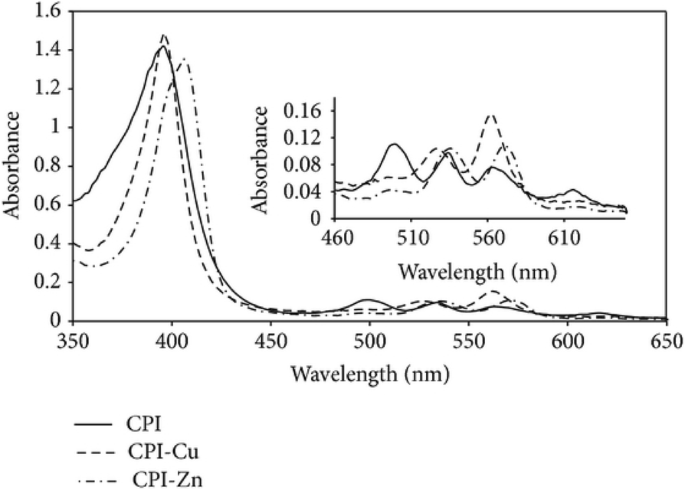
UV-vis spectra and in insert Q-band magnification for CPI, CPICu, and CPIZn incorporated into the TiO2 films [237]
An approach used to enhance the performance of DSSCs is plasmonic effect. Surface plasmon resonance (SPR) is resonant oscillation of conduction electrons at the interface between negative and positive permittivity material stimulated by incident light. In 2013, Gangishetty and co-workers synthesized core-shell NPs comprising a triangular nanoprism core and a silica shell of variable thickness. SPR band centered at ~ 730 nm was observed for the nanoprism Ag particles, which overlapped with the edge of the N719 absorption spectrum very well. They found the incorporation of the nanoprism Ag particles into the photoanode of the DSSCs yielded a 32% increase in the overall PCE [312]. Hossain et al. used the phenomenon of plasmonic with different amounts of silver nanoparticles (Ag NPs) coated with a SiO2 layer prepared as core shell Ag@SiO2 nanoparticles (Ag@SiO2 NPs) and studied the effect of SiO2 -encapsulated Ag nanoparticles in DSSCs. They found the highest PCE of 6.16% for the photoanode incorporated 3 wt% Ag@SiO2; the optimal PCE was 43.25% higher than that of a 0 wt% Ag@SiO2 NP photoanode [313]. However, a simultaneous decrease in the efficiency with further increases in the wt% ratio, i.e., for 4 wt% Ag@SiO2 and 5 wt% Ag@SiO2 , was observed. This decrease for the excess amounts of Ag@SiO2 NPs was attributed to three reasons:(i) reduction in the effective surface area of the films, (ii) absorption of less amount of the dye, and (iii) an increase in the charge-carrier recombination [314]. After analyzing the nyquist plots (as shown in Fig. 25), they have found a decreased diameter of Z2 monotonically as the Ag@SiO2 NP content increased to 3 wt% and R2 decreased from 10.4 to 6.64 Ω for the conventional DSSC to the 3 wt% Ag@SiO2 NPs containing DSSC. Jun et al. used quantum-sized gold NPs to create plasmonic effects in DSSCs [315]. They fabricated the TiO2 photoanode by incorporating the Au nanoparticles (Au NPs) with an average diameter of 5 nm into the commercial TiO2 powder (average diameter 25 nm) and used N749 black dye as a sensitizer. Thus, due to the SPR effect, the efficiency for the DSSC (incorporating Au NPs) was enhanced by about 50% compared to that without Au nanoparticles. Effect of incorporating green-synthesized Ag NPs into the TiO2 photoanode has been investigated in 2017 [316]. Uniform Ag NPs synthesized by treating silver ions with Peltophorum pterocarpum flower extract at room temperature showed the Ag NPs as polycrystalline in nature with face centered cubic lattice with an approximate size in the range of 20–50 nm [316]. The PCE of the device was improved from 2.83 to 3.62% with increment around 28% after incorporation of the 2 wt% of the Ag NPs due to the plasmonic effect of the modified electrode. Bakr et al. have fabricated Z907 dye-sensitized solar cell using gold nanoparticles prepared by pulsed Nd:YAG laser ablation in ethanol at wavelength of 1064 nm [63]. The addition of synthesized Au NPs to the Z907 dye increased the absorption of the Z907 dye, thus achieving ɳ = 1.284% for the cell without Au NPs and 2.357% for the cell incorporating the Au NPs. Recently, in 2018, a novel 3-D transparent photoanode and scattering center design was applied as to increase the energy conversion efficiency from 6.3 to 7.2% of the device [317] because the plasmonics plays an important role in the absorption of light and thus, the application is developing at a very fast pace and grabbing a lot of attention worldwide in the last few years. Recently, a study on incorporation of Mn 2+ into CdSe quantum dots was carried out by Zhang and group [318]. An improved efficiency from 3.4% (CdS/CdSe) to 4.9% (CdS/Mn-CdSe) was achieved for the device upon the addition of Mn 2+ into CdSe because when Mn 2+ is doped into the CdSe (as shown in Fig. 26), the QDs on the surface of the film became compact and the voids among the particles were small, thus reducing the recombination of photogenerated electrons. Also with the loading of Mn 2+ into the CdSe, the size of the QD clusters was increased. However, in QDSCs (quantum dot-sensitized solar cells), there is an inefficient transfer of electrons through the mesoporous semi-conductor layer [319], because their application on a commercial level is still far off. Thus, Surana et al. reported the assembling of CdSe QDs, tuned for photon trapping at different wavelengths in order to achieve an optimum band alignment for better charge transfer in QDSC [319]. TiO2 hollow spheres (THSs) synthesized by the sacrifice template method was reported as a scattering layer for a bi-layered photoanode for DSSCs by Zhang and co-workers [320]. They used the mixture of multi-walled carbon nanotubes with P25 as an under layer and THSs as an overlayer for the photoanode which showed good light scattering ability. The cross-sectional FESEM images revealed the disordered mecroporous network for the scattering layer containing THSs which was supposed to be responsible for the enhanced light absorption and the transfer of electrolyte. Thus, ɳ = 5.13% was achieved for P25/MWNTs-THSs, whereas 4.49% of efficiency was reported for a pure P25 photoanode-based DSSC. Also, the electron lifetime (τ e ) estimated for pure P25 by Bode phase plots of EIS spectra was 5.49 ms; however, 7.96 ms was shown for P25/MWNTs-THSs.
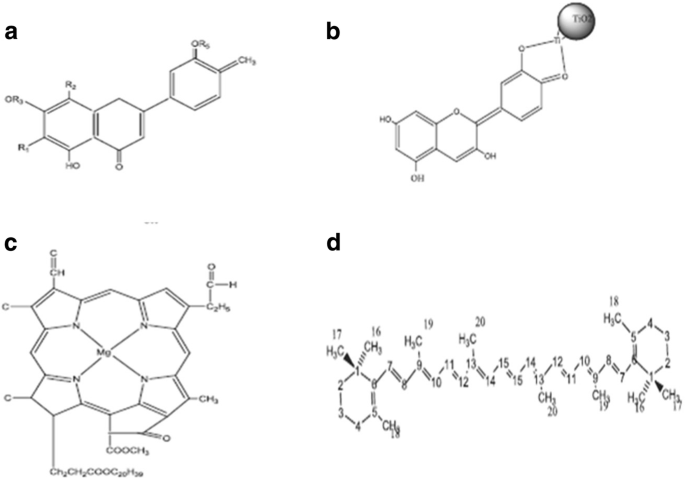
Chemical structures of a anthocyanin, b flavonoid, c β,β-carotene, and d chlorophyll
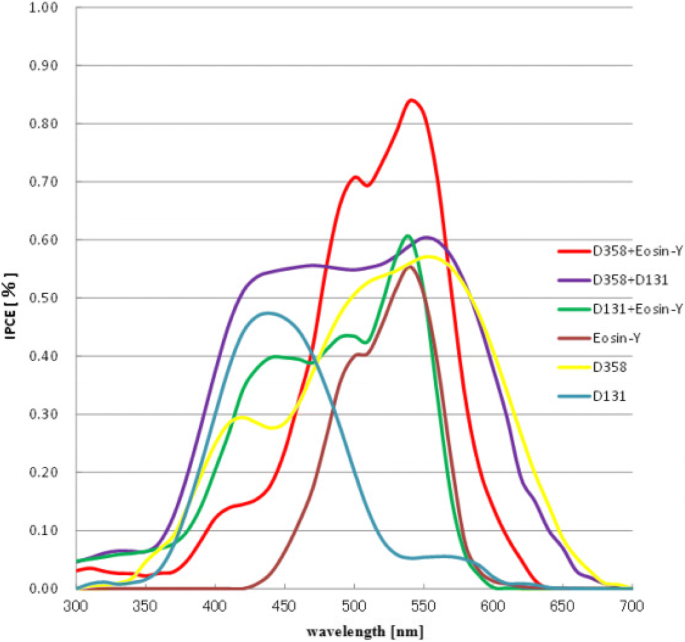
IPCE of mixed pigment and single pigments, where single pigment were Eosin Y, D131, and D358 and mixed pigments were D358 and Eosin Y; D358 and D131; D131 and Eosin Y [311]
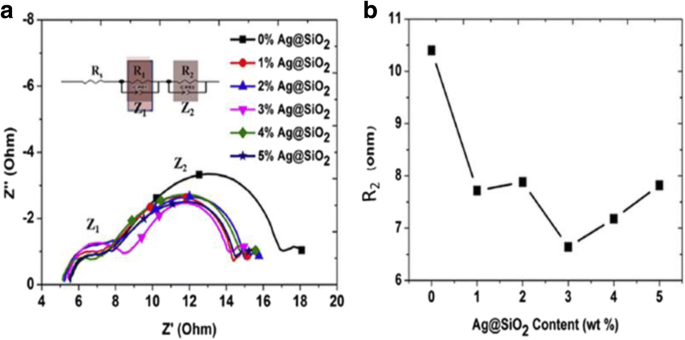
아 Nyquist plots obtained from the EIS of DSSCs with varying Ag@SiO2 content (inset shows the equivalent circuit). ㄴ R2 ohm with respect to the Ag@SiO2 NPs content [313]

a의 SEM 이미지 CdS/CdSe and b CdS/Mn:CdSe QD sensitization on TiO 2 표면. ㄷ TEM image of CdS/Mn:CdSe QDs [318]
John and group reported the synthesis and application of ZnO-doped TiO2 nanotube/ZnO nanoflake heterostructure as a photoanode in DSSCs for the first time in 2016 [321]. They used different characterization techniques to investigate the layered structure of the novel nanostructure. The Rutherford backscattering spectroscopy revealed that during the doping process, a small percentage of Zn was doped into TONT in addition to the formation of ZnO nanoflakes on the top, which led to a preferential orientation of the nanocrystallites in the tube on annealing. Back in 2017, Zhang et al. reported paper on low-dimensional halide perovskite and their applications in optoelectronics due to the ~ 100% of photoluminescence quantum yields of perovskite quantum dots [322]. The main emphasis of their paper was on the study of halide perovskites and their versatile application, i.e., in optoelectronics in spite of PV applications only. The main role of perovskite nanoparticles in solar cells is being applied as sensitizers. Similarly, in the queue of developing highly efficient DSSCs, Chiang and co-workers fabricated DSSCs based on PtCoFe nanowires with rich {111} facets exhibiting superior I − 3 reduction activity as a counter electrode, which surpassed the previous PCE record of the DSSCs using Ru(II)-based dyes [323]. Recently, in accordance with enhancing the charge collection efficiencies (η coll ) as well as PCE of DSSCs, Kunzmann et al. reported a new strategy of fabricating low-temperature (lt)-sintered DSSC and demonstrated the highest efficacy reported for lt-DSSC to date [324]. They have integrated TiO2 -Ru(II) complex (TiO2 _Ru_IS)-based hybrid NPs into the photoelectrode. Due to a better charge transport and a reduced electron recombination, devices with single-layer photoelectrodes featuring blends of P25 and TiO2 _Ru_IS give rise to a 60% η coll relative to a 46% η coll for devices with P25-based photoelectrodes. Further, for usage of a multilayered photoelectrode architecture with a top layer based on TiO2 _Ru_IS only, devices with an even higher η coll (74%) featuring a η = 8.75% and stabilities of 600 h were shown. The two major rewards obtained for such devices were the dye stability due to its amalgamation into the TiO2 anatase network and, secondly, the enhanced charge collection yield due to its significant resistance towards electron recombination with electrolytes.
The main aim of this study was to put a comprehensive review on new materials for photoanodes, counter electrodes, electrolytes, and sensitizers as to provide low-cost, flexible, environmentally sustainable, and easy to synthesize DSSCs. However, a brief explanation has been given to greater understand the working and components of DSSCs. One of the important emphases in this article has been made to establish a relation between the photosensitizer structure, the interfacial charge transfer reactions, and the device performance which are essential to know as to develop new metal and metal-free organic dyes. In terms of low stability offered by DSSCs, two major issues, i.e., low intrinsic stability and the sealing of the electrolytes (extrinsic stability), have been undertaken in this study. To fulfill huge demand of electricity and power, we have two best possible solutions:this demand should be compensated either by the nuclear fission or by the sun. Even so, the nuclear fission predicted to be the best alternative has great environmental issues as well as a problems associated with its waste disposal. Thus, the second alternative is better to follow. DSSCs are developed as a cheap alternative but the efficiency offered by DSSCs in the field is not sufficient. Thus, we have to do a wide research on all possible aspects of DSSCs. We proposed to develop DSCCs based on different electrodes viz. graphene, nanowires, nanotubes, and quantum dots; new photosensitizers based on metal complexes of Ru or Os/organic metal-free complexes/natural dyes; and new electrolytes based on imidazolium salts/pyridinium salts/conjugated polymers, gel electrolytes, polymer electrolytes, and water-based electrolytes. In summary, so far, extensive studies have been carried out addressing individual challenges associated with working electrode, dye, and electrolytes separately; hence, a comprehensive approach needs to be used where all these issues should be addressed together by choosing appropriate conditions of electrolyte (both in choice of material and structure), optimum dye, and the most stable electrolyte which provides better electron transportation capability.
In terms of their commercial application, a DSSC needs to be sustainable for> 25 years in building-integrated modules to avoid commotion of the building environment for repair or replacement and a lifespan of 5 years is sufficient for portable electronic chargers integrated into apparel and accessories [325]. However, DSSCs are being quite bulky due to their sandwiched glass structure, but the flexible DSSCs (discussed elsewhere) that can be processed using roll-to-roll methods may came as an alternative but then has to compromise with the shorter lifespan. Although the stability and lifetime of a DSSC most probably depend on the encapsulation and sealing as discussed above. Apart from the usage of expensive glass substrates in the case of modules and panels, one of the biggest hurdles is to manufacture glass that is flat at the 10 μm length scale over areas much larger than 30 × 30 cm 2 [326] and the humidity. Another challenge is to choose which metal interconnects in the cells that are more or less corroded to the electrolyte, and high degree of control over cell-to-cell reproducibility is required to achieve same current and/or voltage for all the cells in the module. If the abovementioned challenges would be overcome, then there is no roadblock for the commercial applications of DSSCs, which has been restricted up to an amicable extent. G24i has introduced a DSC module production of 25 MW capacity in 2007 in Cardiff, Wales (UK), with extension plans up to 200 MW by the end of 2008 (http://www. g24i. com), and afterwards, many DSSC demonstration modules are now available. However, the maximum outdoor aging test of DSSCs is reported for 2.5 years up to now [327].
Acetonitrile
은 나노입자
Air mass 1.5
금 나노 입자
Boradiazaindacene
4,5-Bis(4-methoxyphenyl)-1H-imidazole
Carbon
Carbazole
Chenodeoxycholic acid
Cadmium selenide
탄소나노섬유
탄소나노튜브
Conjugated polymer electrolytes
Copper bromide
Copper iodide
Copper thiocyanate
순환 전압전류법
Diketopyrrolopyrrole
Dye-sensitized solar cell database
염료감응 태양전지
Ethylene carbonate
Electron impedance spectroscopy
Ecole Polytechnique Fédèrale de Lausanne
Energy relay dyes
채우기 비율
Fluorescence (Forster) resonance energy transfer
불소 도핑 산화주석
Glucuronic acid
γ-Butyrolactone
Guanidinium thiocyanate
Hafnium oxide
가장 높은 점유 분자 궤도
Hole transport materials
Ionic liquid
Intensity-modulated photovoltage spectroscopy
Incident photon to current conversion efficiency
Iridium
Indium-doped tin oxide
Short circuit current
Liquid crystals
Light harvesting efficiency
가장 낮은 비어 있는 분자 궤도
3-Methoxypropionitrile
Metal to ligand charge transfer
Nanocrystalline
Normal hydrogen electrode
Near-infrared region
아니 -Methylbenzimidazole
아니 -Methylpyrrolidine
나노입자
Osmium
폴리아닐린
Propylene carbonate
전력 변환 효율
Poly(ethylene oxide)
폴리에틸렌 테레프탈레이트
Maximum power output
Phenoxazine
Platinum
Phenothiazine
Photovoltaic
양자점
Quasi-solid-state electrolyte
실내 온도
Ruthenium
포화 칼로멜 전극
Solar cells
Surface plasmon resonance
Solid-state electrolyte
4-Tert-butylpyridine
Transparent conducting oxide
Titanium dioxide
Triphenylamine
Ultraviolet-visible
Open circuit voltage
Working electrode
산화아연
Zinc sulfide
Efficiency
나노물질
초록 삼항 및 합성 MoIn2 S4 고슴도치 볼 구조의 @CNTs 상대 전극(CE)은 손쉬운 1단계 열수 방법을 사용하여 합성되었습니다. 합성 MoIn2 S4 @CNTs 필름은 N2를 통해 큰 비표면적을 보유합니다. 더 많은 전해질을 흡착하고 전극에 더 큰 활성 접촉 영역을 제공하는 데 유리한 흡착-탈착 등온선 테스트. 또한 합성 MoIn2 S4 @CNTs CE는 순환 전압전류법, 전기화학 임피던스 및 Tafel 곡선을 포함한 일련의 전기화학 테스트에서 만들어진 낮은 전하 이동 저항과 미세한 전기촉매 능력을 나타냅니다. 최적의 조
초록 그리드 금속 접촉 영역을 제외하고 1 sun, AM 1.5G 조건에서 전력 변환에서 1.27%의 유효 영역 광전지 효율이 에피택셜 성장한 p-GaN/i-InGaN/n-GaN 다이오드 어레이에 대해 얻어졌습니다. (111)-Si. 단락 전류 밀도는 14.96 mA/cm2입니다. 개방 회로 전압은 0.28 V입니다. 변형 및 결함이 없는 III-질화물 나노로드 어레이 구조 내에서 다중 반사를 통해 획득된 향상된 광 트래핑과 넓은 밴드갭 III-질화물 구성요소에 의해 증폭된 단파장 응답은 장치 성능의 향상을 관찰했습니다. 소개